近观与冥想——对自我世界的重构
发起人:wangxiaoer97 回复数:0
浏览数:1431
最后更新:2010/12/24 13:17:02 by wangxiaoer97
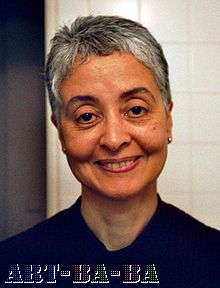
Adrian Piper安德里安.派珀
Adrian Piper安德里安.派珀1948年9月20日出生于美国纽约,是第一代的概念艺术家和分析哲学家。自2005年以来,她一直住在柏林,在那里她运行阿普拉基金会在柏林的工作。

爱丽丝掉进兔子洞,1966年
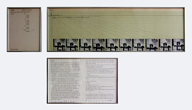
假设:现状#3(for Sole LeWitt)(1968年照片,分析图上方格纸,原打字稿拼贴,复古照片胶印文字,28.4 x86.5厘米;28.4 x22.1厘米;28.5 x43.6厘米)。
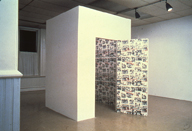
Art for the Artworld Surface Pattern,1976年,混合媒介安装,152.4× 152.4 x213.3厘米:人工木材环境,定制印刷墙纸,音频独白,裸灯泡)。旧金山博物馆收藏

夸张了黑人特征的自画像(1981年,20.3× 25.4厘米)。
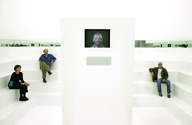
它像什么?它是什么?#3(1991年,视频安装:木结构,镜子,灯饰,影碟,音乐配乐,尺寸变量)。
决定你是谁#1:剥皮的活(1992年;图文混排拼贴画,三片,总额182.8 x388.6厘米)。
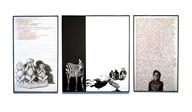
色轮系列#29:Annomayakosha(2000年)

一切#5.2(2004年,制作于2009年。混合媒材装置:木材建筑,文字刻金箔有机玻璃,照明)。

安德里安·派普(Adrian Piper)的个展
“过去的时光:精挑细选1973-1995”
作者:胡畔编译 2010-11-15 来源:artspy艺术眼
Elizabeth Dee画廊日前展出安德里安·派普(Adrian Piper)的个展“过去的时光:精挑细选1973-1995”,作品基本上都来自她最困苦、矛盾的一段时光。展览将由大规模的装置、雕塑系列、墙上挂画以及影像作品组成,带着自传性质,以及对自身身份的质疑和异议。
七部分的雕塑“What It's Like, What It Is #2 (1991)”打破了派普平时惯用的手法,给观众带来一种讽刺的观感体验。灵感则来源于美国历史,从民权运动时代一直到上世纪九十年代初。另外,“Decide Who You Are (1992) ”系列和“Ashes to Ashes (1995)”系列跟美国政治都有关系,包含了人权,种族主义,新解放主义等题材。展览还展出了艺术家的许多影像作品的尝试“20th Century Video Set”,带着剧场派的味道。
这是派普在Elizabeth Dee画廊的第二个个展。20世纪60年代后期以来,派普形成了独特的艺术实践,把明确的政治内容融入到古典雕塑形式,把最小的艺术语汇的概念引入了种族,性别和身份政治问题。她已经开始实行置换和系列化——在她开始这样运用的时候曾被认为是颠覆传统的——一种探究多样性、无限性和观念性的战略措施。近年来,她的方向更趋于哲学化,在一定的空间,限制和潜能都在预先搭建好的网格里出现,而表达出来的内容则满是社会性、种族问题、性别、阶级冲突和社会关系的政治变数。
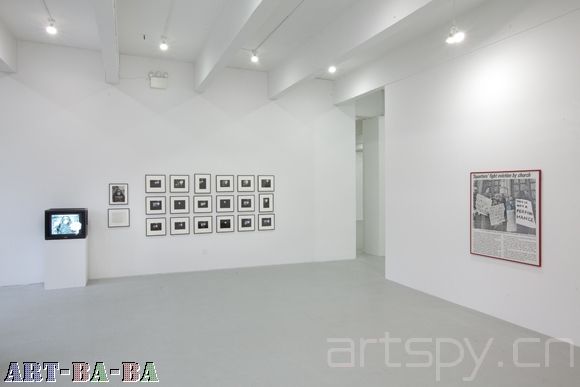
Past Time: Selected Works 1973 - 1995
Installation view

What It's Like, What It Is #2 (1991)
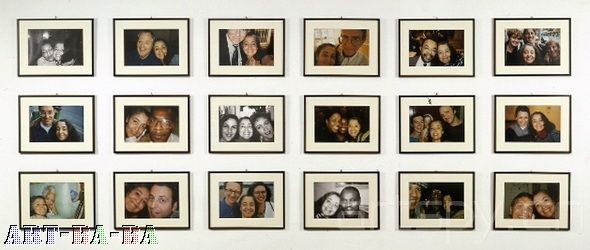
I Am Somebody, The Body of My Friends #1-18, 1992-1995

It’s Just Art, 1980
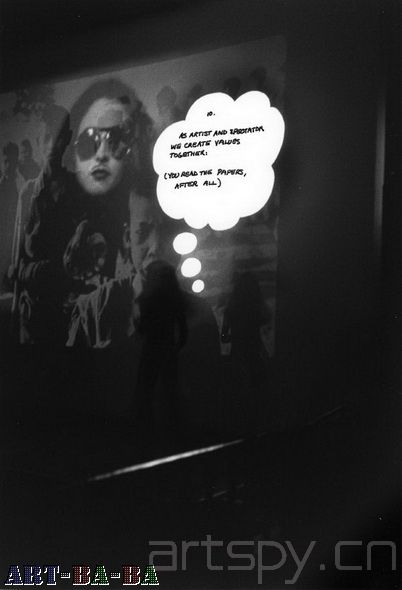
It's Just Art, #10 of 15, 1980
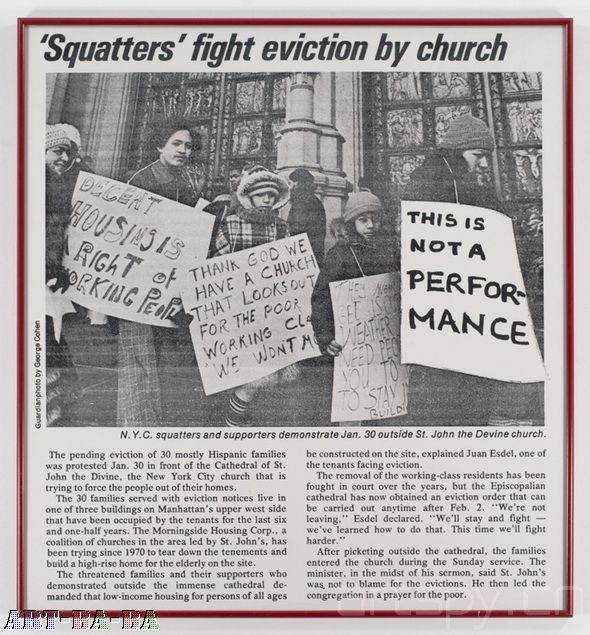
This Is Not the Documentation Of A Performance, 1976
“过去的时光:精挑细选1973-1995”
作者:胡畔编译 2010-11-15 来源:artspy艺术眼
Elizabeth Dee画廊日前展出安德里安·派普(Adrian Piper)的个展“过去的时光:精挑细选1973-1995”,作品基本上都来自她最困苦、矛盾的一段时光。展览将由大规模的装置、雕塑系列、墙上挂画以及影像作品组成,带着自传性质,以及对自身身份的质疑和异议。
七部分的雕塑“What It's Like, What It Is #2 (1991)”打破了派普平时惯用的手法,给观众带来一种讽刺的观感体验。灵感则来源于美国历史,从民权运动时代一直到上世纪九十年代初。另外,“Decide Who You Are (1992) ”系列和“Ashes to Ashes (1995)”系列跟美国政治都有关系,包含了人权,种族主义,新解放主义等题材。展览还展出了艺术家的许多影像作品的尝试“20th Century Video Set”,带着剧场派的味道。
这是派普在Elizabeth Dee画廊的第二个个展。20世纪60年代后期以来,派普形成了独特的艺术实践,把明确的政治内容融入到古典雕塑形式,把最小的艺术语汇的概念引入了种族,性别和身份政治问题。她已经开始实行置换和系列化——在她开始这样运用的时候曾被认为是颠覆传统的——一种探究多样性、无限性和观念性的战略措施。近年来,她的方向更趋于哲学化,在一定的空间,限制和潜能都在预先搭建好的网格里出现,而表达出来的内容则满是社会性、种族问题、性别、阶级冲突和社会关系的政治变数。

Past Time: Selected Works 1973 - 1995
Installation view

What It's Like, What It Is #2 (1991)

I Am Somebody, The Body of My Friends #1-18, 1992-1995

It’s Just Art, 1980

It's Just Art, #10 of 15, 1980

This Is Not the Documentation Of A Performance, 1976
阿德里安玛格丽特史密斯派珀(生于1948年9月20号)是第一代的概念艺术家和分析哲学家,出生在纽约市和科德角,从美国移民前,她在马萨诸塞州的科德角生活了很多年。自2005年以来,她一直住在柏林,在那里她运行阿普拉基金会柏林工作。
派普进入了“河滨教堂”、新林肯学校文法学院、高中,以及高中时期的“艺术学生联盟”。20岁的时候,她开始在国际上举办艺术展,1969年毕业于A。A。视觉艺术学院。在“Fine Art”她专注于绘画和雕塑,并且继续创作和展示自己的作品。1974年,她的哲学论文通过,获得了荣誉以及文学士学位,而且,她在纽约市立大学的附修科目——中世纪以及文艺复兴时期的音乐学也获得了优异的成绩。她进入了哈佛大学的哲学研究生院,她在1977年获得了硕士学位,1981年,在John Rawls的监督下,她获得了博士学位。1977-1978年,她还和Dieter Henrich一起在海德堡大学研究康德和黑格尔。她的正规教育持续了27年之久。
在哲学上的贡献:
阿德里安派普任教于乔治敦大学,哈佛大学,密歇根大学,斯坦福大学和加州大学圣地亚哥分校,她是哲学老师。跟随开创性的先驱Joyce Mitchell Cook博士,1987年,她成为哲学领域里第一个非洲裔美国女教授。因为她拒绝返回美国,美国运输安全管理局把她列入了可疑乘客的观察名单中,2008年,威尔斯利学院强行中止了她哲学教授的教职。她主要的哲学类出版物,大多是关于伦理学、康德以及伦理学史。
她的两卷本康德后伦理学研究,《理性与自我结构》,卷一是休谟的构想,以及理性与自我结构;第二卷是“一个康德式的概念”,2008年由剑桥大学出版社出版,作为一个开放的电子书,至今可在她的网站上访问。本研究审慎调查了20世纪重要的道德理论,发展出了对于康德纯粹理性的伦理学批判。
《理性与自我结构》是她34年工作的高潮和精华,其中的部分文章以前曾经发表过。有一篇早期文章,1985年的《两个自我观念》介绍了派普对休谟和康德关于自我的不同概念,其动机以及合理性。在《理性与自我结构》中,派普认为,在20世纪下半叶看到了英美在分析哲学伦理学方面互夺霸权的战斗。
派普进入了“河滨教堂”、新林肯学校文法学院、高中,以及高中时期的“艺术学生联盟”。20岁的时候,她开始在国际上举办艺术展,1969年毕业于A。A。视觉艺术学院。在“Fine Art”她专注于绘画和雕塑,并且继续创作和展示自己的作品。1974年,她的哲学论文通过,获得了荣誉以及文学士学位,而且,她在纽约市立大学的附修科目——中世纪以及文艺复兴时期的音乐学也获得了优异的成绩。她进入了哈佛大学的哲学研究生院,她在1977年获得了硕士学位,1981年,在John Rawls的监督下,她获得了博士学位。1977-1978年,她还和Dieter Henrich一起在海德堡大学研究康德和黑格尔。她的正规教育持续了27年之久。
在哲学上的贡献:
阿德里安派普任教于乔治敦大学,哈佛大学,密歇根大学,斯坦福大学和加州大学圣地亚哥分校,她是哲学老师。跟随开创性的先驱Joyce Mitchell Cook博士,1987年,她成为哲学领域里第一个非洲裔美国女教授。因为她拒绝返回美国,美国运输安全管理局把她列入了可疑乘客的观察名单中,2008年,威尔斯利学院强行中止了她哲学教授的教职。她主要的哲学类出版物,大多是关于伦理学、康德以及伦理学史。
她的两卷本康德后伦理学研究,《理性与自我结构》,卷一是休谟的构想,以及理性与自我结构;第二卷是“一个康德式的概念”,2008年由剑桥大学出版社出版,作为一个开放的电子书,至今可在她的网站上访问。本研究审慎调查了20世纪重要的道德理论,发展出了对于康德纯粹理性的伦理学批判。
《理性与自我结构》是她34年工作的高潮和精华,其中的部分文章以前曾经发表过。有一篇早期文章,1985年的《两个自我观念》介绍了派普对休谟和康德关于自我的不同概念,其动机以及合理性。在《理性与自我结构》中,派普认为,在20世纪下半叶看到了英美在分析哲学伦理学方面互夺霸权的战斗。
Over the Edge | 边缘上
(英文“Over the edge”也是疯掉的意思)
1965-1967
"边缘上“是艺术家从16岁到18岁画的一系列绘画和油画。这系列作品也包括LSD(一种毒品)的系列。
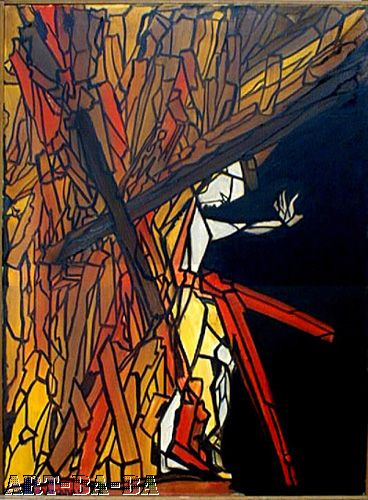
Over the Edge | 边缘上
(1965; 18 x 24”, oil paint 油画)

Over the Edge 1 | 边缘上 1
(1967; 8.5 x 4" drawing; pencil on lined paper 绘画)

Over the Edge 2 | 边缘上 2
(1967; 8.5 x 11" drawing; pencil on lined paper 绘画)
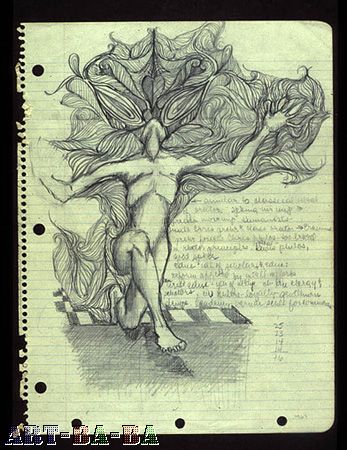
Over the Edge 3 | 边缘上 3
(1967; 8.5 x 11" drawing; pencil on lined paper 绘画)
Adrian Piper Over the Edge:
An Introduction
by Robert Del Principe
The work of Adrian Piper has been described in many ways—groundbreaking, visionary, radical, political, confrontational, didactic, and belligerent, to name a few. However, it's fairly safe to say that, until now, the word "psychedelic" was not often used. Now, in Adrian Piper Over the Edge, LSD Drawings 1965-1967, a joint exhibit at the Emi Fontana Gallery and online at adrianpiper.com, the word "psychedelic" is precisely what comes to mind. Over the Edge, a series of paintings and drawings executed between the ages of 16 and 18 and collected and shown here for the first time, provides the rare opportunity to reintroduce the early work of an artist established in the art world over thirty years.
The works comprising the LSD series are clearly different in style from Piper’s more well-known conceptual work. They are, to begin, representational paintings and drawings. However, they also have many stylistic and thematic elements in common with later work, and they uncover some artistic and cultural influences that are redeployed in the minimalist and conceptual aesthetic Piper adopts from 1967 onwards. The paintings, strikingly colorful and verging on the phantasmagoric, bring together an unconscious amalgam of expressionism, cubism, op art, and 60s album cover art in an exploration of the boundaries of perception. In the Alice in Wonderland paintings, LSD Third Eye, as well as the drawings for Over the Edge, there is an incorporation of a funk psychedelic aesthetic that later resurfaces in the 80s Funk Lessons. Piper, moreover, displays a serious concern for spatial relations that informs her later works and thinking. The drawings, intricately detailed, display an elegant natural draftsmanship that is present, though often overlooked, in later works such as the Vanilla Nightmares series and the Donald Kuspit Exrtermination fantasies.
And, of course, there's the LSD. LSD, if anything rational can be said of it, alters our immediate (and arguably, long-term) perception of the world. Piper's work, both artistic and philosophical, has always been preoccupied with the problem of representation generally, with immediate perception — what she calls the indexical present (the concrete immediate here and now) — and with the concepts that determine this perception. This is perhaps clearer in later work, but the early paintings and drawings reveal her emerging preoccupation with the indexical present. Here the breakdown, veiling, and unveiling of perception, represented with mosaics, disintegrating layers, and broken shapes and body parts, expose Piper's nascent awareness of the importance of the concept and its role in determining our experience. The influence of LSD, both real and in the use of what is now viewed as prototypical psychedelic imagery, highlights the failure of the conceptual framework of perception and the revelation of possible alternate realities. In this light, then, the early paintings and drawings can be understood as representing a first step, an "awakening," to a lifelong examination of the power and fragility of the concepts that determine our experience.
Beginning in the late ‘60s and early ‘70s, Piper's concerns with perception find a broader theoretical vocabulary in her philosophical work on Kant. The fundamental intuition of Kantian epistemology set forth in the Critique of Pure Reason goes something like this. Human experience and knowledge is founded on a set of universal categories and concepts inherent in human subjectivity that structure and unify experience, and therefore make it possible. There is thus a fundamental conceptual framework through which we experience and understand the world, and this set of concepts is necessary for us to have unified experience. An experience that does not fit neatly into these categories cannot be understood in a coherent manner. Naturally this raises many philosophical dilemmas, the most important for this discussion being the origin of these concepts. Are all of our concepts innate, or are they acquired? Is our thinking fixed, or can we learn to think in new ways? For Kant there are two kinds of concepts: a priori (pure, universal), and a posteriori, i.e. those based on experience. While the pure concepts are hardwired and unchangeable, prior to experience, the a posteriori (empirical) concepts are culled from experience, and therefore, potentially flexible. They in fact allow us to have and understand particular, empirical experiences. However, they are open to modification based on these experiences.
For Piper, Kant’s philosophical analysis becomes a point of departure, and it serves to theoretically ground her preoccupation with immediate perception. She seizes on his fundamental idea that there are conceptual thought processes that shape our experience, and deploys it to examine the concepts that constitute our experience of race, ethnicity, and xenophobia. Race is not a fixed a priori category, and it is not biological or genetic. Rather, it is an empirical concept that is open to modification. Racism, then, takes place at the concrete and immediate moment of perception, and more specifically, through the concepts that determine our perception. Moreover, the very possibility that these concepts are mutable and not fixed is a source of hope, providing more resolve for her mission to challenge the concrete experience of racism.
These concerns become more forcefully articulated in her later political works, such as the Mythic Being, Funk Lessons, Cornered, Pretend, Ur- Mutter, Black Box/White Box, where she incorporates audio, performance, video and iconographic imagery to explore the immediate here and now of perception. The viewer, in turn, is confronted with everyday images and language that have become ingrained in our consciousness and that refer to the concepts that underlie our everyday experience of race, racial stereotyping, and xenophobia. Similarly (but more recently) in The Color Wheel Series (2000), Piper employs the vocabulary of the Western rationalist tradition and the Vedantic philosophical tradition in Hinduism as a tool to peel away the koshas, or sheaths, which are layers of illusory impositions that cover the true self. From the standpoint of Western Rationalism, Piper draws on the examination of color as a secondary quality that is inherent in the perceiver, not in the object itself. Like the disintegrating and distorted layers covering the subjects in the LSD paintings and drawings, color is imposed upon perception by the perceiver, not inherent in the object itself.
It is, of course, somewhat paradoxical that these early works, in drawing on the illusory, non-rational experience of LSD, help to reveal Piper’s emerging theoretical and aesthetic concerns with the mechanisms of rational thinking. Nonetheless, the LSD paintings and drawings mark an important moment in Piper's artistic career. Understood as an awakening, these paintings and drawings, the subsequent turn to conceptual art in the late 60s, and her ongoing philosophical investigations, all combine to support Piper's goal of presenting, confronting, and ideally, modifying the concepts that create our reality. By drawing on a myriad of cultural and intellectual influences–including 60's psychedelia, Lewis Carroll , a longstanding yoga practice, and her philosophical work in the Western Rationalist tradition–Piper makes the implications of her social and political attacks on racism and xenophobia clear: color, and race, are not biological or genetic, but impositions upon the "true self." Whether one accepts this notion of the true self or not, Piper's work produces an unavoidable recognition of the concepts that determine our individual experiences, and shows an unwavering hope that these concepts can and will be changed.
(英文“Over the edge”也是疯掉的意思)
1965-1967
"边缘上“是艺术家从16岁到18岁画的一系列绘画和油画。这系列作品也包括LSD(一种毒品)的系列。

Over the Edge | 边缘上
(1965; 18 x 24”, oil paint 油画)

Over the Edge 1 | 边缘上 1
(1967; 8.5 x 4" drawing; pencil on lined paper 绘画)

Over the Edge 2 | 边缘上 2
(1967; 8.5 x 11" drawing; pencil on lined paper 绘画)

Over the Edge 3 | 边缘上 3
(1967; 8.5 x 11" drawing; pencil on lined paper 绘画)
Adrian Piper Over the Edge:
An Introduction
by Robert Del Principe
The work of Adrian Piper has been described in many ways—groundbreaking, visionary, radical, political, confrontational, didactic, and belligerent, to name a few. However, it's fairly safe to say that, until now, the word "psychedelic" was not often used. Now, in Adrian Piper Over the Edge, LSD Drawings 1965-1967, a joint exhibit at the Emi Fontana Gallery and online at adrianpiper.com, the word "psychedelic" is precisely what comes to mind. Over the Edge, a series of paintings and drawings executed between the ages of 16 and 18 and collected and shown here for the first time, provides the rare opportunity to reintroduce the early work of an artist established in the art world over thirty years.
The works comprising the LSD series are clearly different in style from Piper’s more well-known conceptual work. They are, to begin, representational paintings and drawings. However, they also have many stylistic and thematic elements in common with later work, and they uncover some artistic and cultural influences that are redeployed in the minimalist and conceptual aesthetic Piper adopts from 1967 onwards. The paintings, strikingly colorful and verging on the phantasmagoric, bring together an unconscious amalgam of expressionism, cubism, op art, and 60s album cover art in an exploration of the boundaries of perception. In the Alice in Wonderland paintings, LSD Third Eye, as well as the drawings for Over the Edge, there is an incorporation of a funk psychedelic aesthetic that later resurfaces in the 80s Funk Lessons. Piper, moreover, displays a serious concern for spatial relations that informs her later works and thinking. The drawings, intricately detailed, display an elegant natural draftsmanship that is present, though often overlooked, in later works such as the Vanilla Nightmares series and the Donald Kuspit Exrtermination fantasies.
And, of course, there's the LSD. LSD, if anything rational can be said of it, alters our immediate (and arguably, long-term) perception of the world. Piper's work, both artistic and philosophical, has always been preoccupied with the problem of representation generally, with immediate perception — what she calls the indexical present (the concrete immediate here and now) — and with the concepts that determine this perception. This is perhaps clearer in later work, but the early paintings and drawings reveal her emerging preoccupation with the indexical present. Here the breakdown, veiling, and unveiling of perception, represented with mosaics, disintegrating layers, and broken shapes and body parts, expose Piper's nascent awareness of the importance of the concept and its role in determining our experience. The influence of LSD, both real and in the use of what is now viewed as prototypical psychedelic imagery, highlights the failure of the conceptual framework of perception and the revelation of possible alternate realities. In this light, then, the early paintings and drawings can be understood as representing a first step, an "awakening," to a lifelong examination of the power and fragility of the concepts that determine our experience.
Beginning in the late ‘60s and early ‘70s, Piper's concerns with perception find a broader theoretical vocabulary in her philosophical work on Kant. The fundamental intuition of Kantian epistemology set forth in the Critique of Pure Reason goes something like this. Human experience and knowledge is founded on a set of universal categories and concepts inherent in human subjectivity that structure and unify experience, and therefore make it possible. There is thus a fundamental conceptual framework through which we experience and understand the world, and this set of concepts is necessary for us to have unified experience. An experience that does not fit neatly into these categories cannot be understood in a coherent manner. Naturally this raises many philosophical dilemmas, the most important for this discussion being the origin of these concepts. Are all of our concepts innate, or are they acquired? Is our thinking fixed, or can we learn to think in new ways? For Kant there are two kinds of concepts: a priori (pure, universal), and a posteriori, i.e. those based on experience. While the pure concepts are hardwired and unchangeable, prior to experience, the a posteriori (empirical) concepts are culled from experience, and therefore, potentially flexible. They in fact allow us to have and understand particular, empirical experiences. However, they are open to modification based on these experiences.
For Piper, Kant’s philosophical analysis becomes a point of departure, and it serves to theoretically ground her preoccupation with immediate perception. She seizes on his fundamental idea that there are conceptual thought processes that shape our experience, and deploys it to examine the concepts that constitute our experience of race, ethnicity, and xenophobia. Race is not a fixed a priori category, and it is not biological or genetic. Rather, it is an empirical concept that is open to modification. Racism, then, takes place at the concrete and immediate moment of perception, and more specifically, through the concepts that determine our perception. Moreover, the very possibility that these concepts are mutable and not fixed is a source of hope, providing more resolve for her mission to challenge the concrete experience of racism.
These concerns become more forcefully articulated in her later political works, such as the Mythic Being, Funk Lessons, Cornered, Pretend, Ur- Mutter, Black Box/White Box, where she incorporates audio, performance, video and iconographic imagery to explore the immediate here and now of perception. The viewer, in turn, is confronted with everyday images and language that have become ingrained in our consciousness and that refer to the concepts that underlie our everyday experience of race, racial stereotyping, and xenophobia. Similarly (but more recently) in The Color Wheel Series (2000), Piper employs the vocabulary of the Western rationalist tradition and the Vedantic philosophical tradition in Hinduism as a tool to peel away the koshas, or sheaths, which are layers of illusory impositions that cover the true self. From the standpoint of Western Rationalism, Piper draws on the examination of color as a secondary quality that is inherent in the perceiver, not in the object itself. Like the disintegrating and distorted layers covering the subjects in the LSD paintings and drawings, color is imposed upon perception by the perceiver, not inherent in the object itself.
It is, of course, somewhat paradoxical that these early works, in drawing on the illusory, non-rational experience of LSD, help to reveal Piper’s emerging theoretical and aesthetic concerns with the mechanisms of rational thinking. Nonetheless, the LSD paintings and drawings mark an important moment in Piper's artistic career. Understood as an awakening, these paintings and drawings, the subsequent turn to conceptual art in the late 60s, and her ongoing philosophical investigations, all combine to support Piper's goal of presenting, confronting, and ideally, modifying the concepts that create our reality. By drawing on a myriad of cultural and intellectual influences–including 60's psychedelia, Lewis Carroll , a longstanding yoga practice, and her philosophical work in the Western Rationalist tradition–Piper makes the implications of her social and political attacks on racism and xenophobia clear: color, and race, are not biological or genetic, but impositions upon the "true self." Whether one accepts this notion of the true self or not, Piper's work produces an unavoidable recognition of the concepts that determine our individual experiences, and shows an unwavering hope that these concepts can and will be changed.
Drawings About Paper, Writing About Words
关于纸的绘画,关于词的写作
绘画拼贴
1967

Drawings About Paper, Writing About Words #17
(1967; collaged drawing, 9 x 12”: paper, glue, pastel, pencil)

Drawings About Paper, Writing About Words #27
(1967; collaged drawing, 9 x 12”: paper, glue, pastel, pencil)
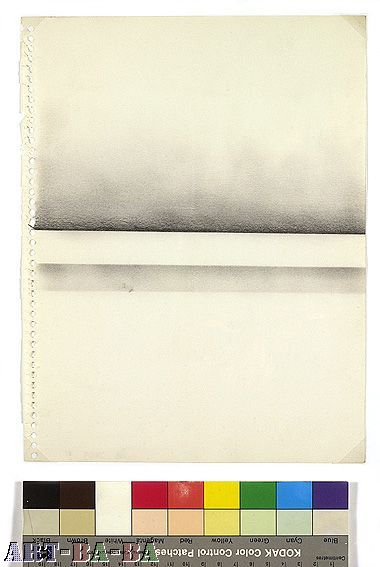
Drawings About Paper, Writing About Words #33
(1967; collaged drawing, 9 x 12”: paper, glue, pastel, pencil)
关于纸的绘画,关于词的写作
绘画拼贴
1967

Drawings About Paper, Writing About Words #17
(1967; collaged drawing, 9 x 12”: paper, glue, pastel, pencil)

Drawings About Paper, Writing About Words #27
(1967; collaged drawing, 9 x 12”: paper, glue, pastel, pencil)

Drawings About Paper, Writing About Words #33
(1967; collaged drawing, 9 x 12”: paper, glue, pastel, pencil)
犹他州-曼哈顿转移
地图拼贴
1968
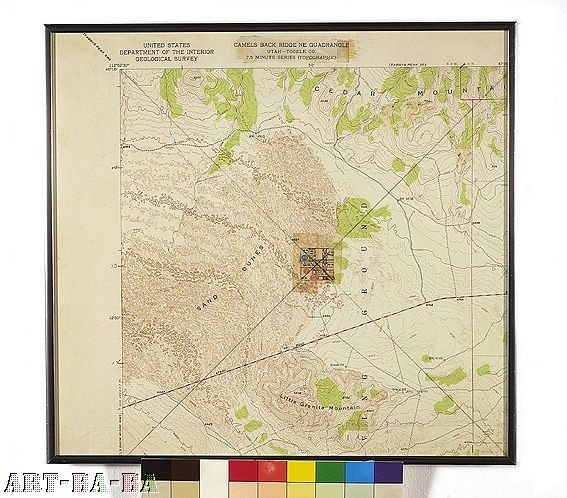
Utah-Manhattan Transfer #1 of 2
(1968; map collage, 12.25 x 12”: Times Square Manhattan onto Dugway Proving Grounds)
1968,地图拼贴,12.25 x 12", 从曼哈顿时代广场到杜格威试验基地

Utah-Manhattan Transfer #2
(1968; Map collage, 13x14”: Dugway Proving Grounds onto Times Square Manhattan)
1968,地图拼贴,13 x 14", 从杜格威试验基地到曼哈顿时代广场
地图拼贴
1968

Utah-Manhattan Transfer #1 of 2
(1968; map collage, 12.25 x 12”: Times Square Manhattan onto Dugway Proving Grounds)
1968,地图拼贴,12.25 x 12", 从曼哈顿时代广场到杜格威试验基地

Utah-Manhattan Transfer #2
(1968; Map collage, 13x14”: Dugway Proving Grounds onto Times Square Manhattan)
1968,地图拼贴,13 x 14", 从杜格威试验基地到曼哈顿时代广场
假设系列 |(1968-69)
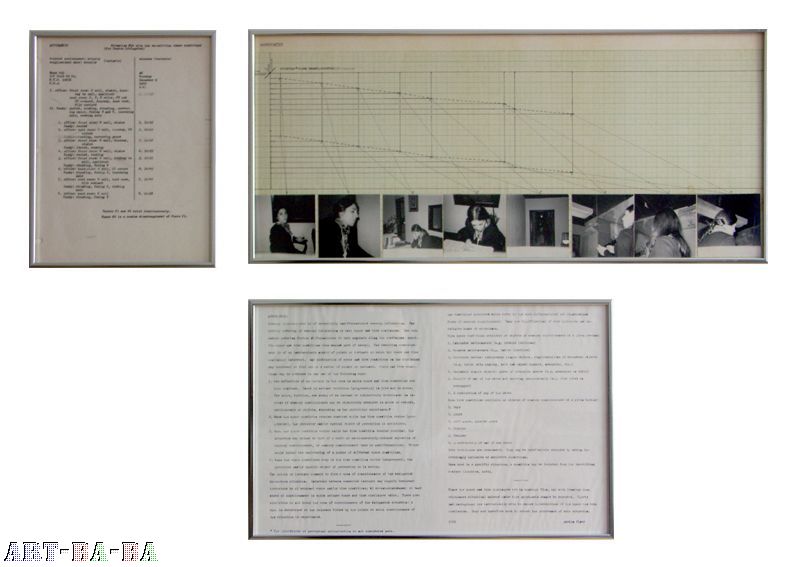
Hypothesis: Situation #14 |假设:14号情况
(1969; photo-diagram collage: graph paper, B&W photographs, ink diagrams, vintage mimeographed forms with typescript text, vintage photo offset two-page essay, “Hypothesis” (1968))
The Hypothesis Series (1968-69) |假设系列(1968-69)
假设系列第一次在由Joseph Kosuth策划的一个展览”概念艺术与概念方面“(1970)里展出。后来为了反抗尼克松到柬埔寨的侵入以及肯特州和约克逊州大学的学生枪杀,作品被移走。这系列作品涉及到我从纯粹的概念艺术到行为艺术的转移。
这个作品是一个”天真现实透视“。
The Hypothesis series (1968-1969) was first exhibited in the group show curated by Joseph Kosuth, Conceptual Art and Conceptual Aspects (1970), and was withdrawn from that exhibition in protest against Nixon’s invasion of Cambodia and the shooting of students at Kent State and Jackson State Universities. It marks the moment of transition in my work from “pure” first-generation Conceptual Art to performance/new genres.
Before this series, my preoccupation with the grid as a coordinate system for locating infinite numbers of points in space and time found expression in wall works, floor sculptures, and page works using maps, graph paper and/or texts with indexical language and infinite arithmetic progressions or linguistic permutations. In these works the perspective is distanced, but unmediated by considerations of subjectivity or perceptual limitation; it is a fixed Naïve Realist perspective, in which the viewer’s eyes are windows onto the infinitesimal and unbounded dimensions of reality I am investigating.
By contrast, the Hypothesis series acknowledges the perspectival character of human perception, by charting and documenting my navigation through space and time as myself a moving or stationary object with the capacity for sensory perception and the ability to self-consciously register those perspectival perceptions at fixed intervals. Thus the shift in perspective that characterizes this project implicitly introduces issues of subjectivity, personal identity, self-knowledge, self-objectification and difference that I then confront directly in the later Catalysis and Mythic Being series of the early 1970s.
Each work in the Hypothesis series contains certain constants: the series of photographs documenting my own spatiotemporal passage through a situation; the grid system that locates that passage at its series of space-time coordinates; the accompanying legend that lists and describes the intervals; and the accompanying short essay that explains the underlying philosophy of this work, that space and time are forms of perception that condition consciousness relative to circumstance (it was this essay that led a philosopher friend to recommend that I read Kant’s Critique of Pure Reason, and so to my decision to study philosophy in earnest). Specific to each work is the actual situation or context I am registering: meditating, eating breakfast, reading the New York Review of Books, walking around a chair or through my loft, taking a walk outside, interacting with a colleague at the employment agency where I was working, watching television, etc.
Hypothesis: Situation #14(1969; graph paper, B&W photographs, ink diagrams, vintage mimeographed form with typescript text, vintage photo offset two-page essay). [Time is variable, space is variable: I interact with Sandy Livingston at the Cameo Employment Agency while she is doing her job and having lunch at her desk].
In this particular work in the Hypothesis series, I map my own movement through space and time relative to that of a colleague, Sandy Livingston, at the Cameo Employment Agency where she worked as a full-time receptionist and I worked as a part-time bookkeeper. I devoted this work to Sandy’s passage through space and time relative to mine because I admired her. She was a divorced single mother who worked full time to support her son. She was of Italian heritage but once told me she had married her husband, Wesley Livingston, because she thought her son would do better in America with a last name like “Livingston” than with a last name like “Colluccio.” She worked very hard, obsessed constantly about her son and about remarrying in order to give him a father, and had an earthy sense of humor about her own situation. This was my first feminist work of art.
© Adrian Piper Research Archive 2006

Hypothesis: Situation #14 |假设:14号情况
(1969; photo-diagram collage: graph paper, B&W photographs, ink diagrams, vintage mimeographed forms with typescript text, vintage photo offset two-page essay, “Hypothesis” (1968))
The Hypothesis Series (1968-69) |假设系列(1968-69)
假设系列第一次在由Joseph Kosuth策划的一个展览”概念艺术与概念方面“(1970)里展出。后来为了反抗尼克松到柬埔寨的侵入以及肯特州和约克逊州大学的学生枪杀,作品被移走。这系列作品涉及到我从纯粹的概念艺术到行为艺术的转移。
这个作品是一个”天真现实透视“。
The Hypothesis series (1968-1969) was first exhibited in the group show curated by Joseph Kosuth, Conceptual Art and Conceptual Aspects (1970), and was withdrawn from that exhibition in protest against Nixon’s invasion of Cambodia and the shooting of students at Kent State and Jackson State Universities. It marks the moment of transition in my work from “pure” first-generation Conceptual Art to performance/new genres.
Before this series, my preoccupation with the grid as a coordinate system for locating infinite numbers of points in space and time found expression in wall works, floor sculptures, and page works using maps, graph paper and/or texts with indexical language and infinite arithmetic progressions or linguistic permutations. In these works the perspective is distanced, but unmediated by considerations of subjectivity or perceptual limitation; it is a fixed Naïve Realist perspective, in which the viewer’s eyes are windows onto the infinitesimal and unbounded dimensions of reality I am investigating.
By contrast, the Hypothesis series acknowledges the perspectival character of human perception, by charting and documenting my navigation through space and time as myself a moving or stationary object with the capacity for sensory perception and the ability to self-consciously register those perspectival perceptions at fixed intervals. Thus the shift in perspective that characterizes this project implicitly introduces issues of subjectivity, personal identity, self-knowledge, self-objectification and difference that I then confront directly in the later Catalysis and Mythic Being series of the early 1970s.
Each work in the Hypothesis series contains certain constants: the series of photographs documenting my own spatiotemporal passage through a situation; the grid system that locates that passage at its series of space-time coordinates; the accompanying legend that lists and describes the intervals; and the accompanying short essay that explains the underlying philosophy of this work, that space and time are forms of perception that condition consciousness relative to circumstance (it was this essay that led a philosopher friend to recommend that I read Kant’s Critique of Pure Reason, and so to my decision to study philosophy in earnest). Specific to each work is the actual situation or context I am registering: meditating, eating breakfast, reading the New York Review of Books, walking around a chair or through my loft, taking a walk outside, interacting with a colleague at the employment agency where I was working, watching television, etc.
Hypothesis: Situation #14(1969; graph paper, B&W photographs, ink diagrams, vintage mimeographed form with typescript text, vintage photo offset two-page essay). [Time is variable, space is variable: I interact with Sandy Livingston at the Cameo Employment Agency while she is doing her job and having lunch at her desk].
In this particular work in the Hypothesis series, I map my own movement through space and time relative to that of a colleague, Sandy Livingston, at the Cameo Employment Agency where she worked as a full-time receptionist and I worked as a part-time bookkeeper. I devoted this work to Sandy’s passage through space and time relative to mine because I admired her. She was a divorced single mother who worked full time to support her son. She was of Italian heritage but once told me she had married her husband, Wesley Livingston, because she thought her son would do better in America with a last name like “Livingston” than with a last name like “Colluccio.” She worked very hard, obsessed constantly about her son and about remarrying in order to give him a father, and had an earthy sense of humor about her own situation. This was my first feminist work of art.
© Adrian Piper Research Archive 2006
Context #7|7号背静
1970,综合材料装置(局部)
(1970; mixed media installation for the Museum of Modern Art Information Exhibition: seven black vinyl three-ring loose-leaf notebooks, 9”x12”x3” each, 8.5”x11” three-hole punch blank pages, ballpoint pen, frontispiece as sign mounted on wall).
Detail: Frontispiece
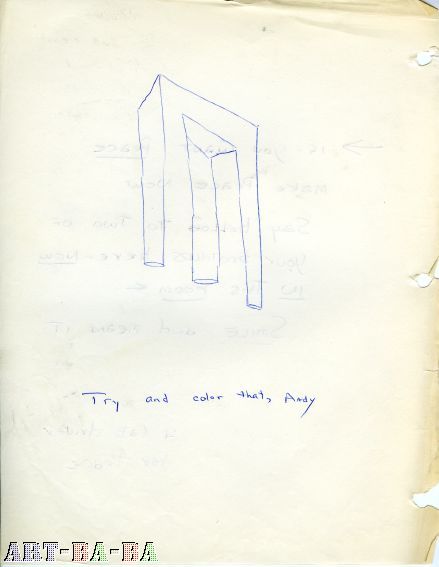
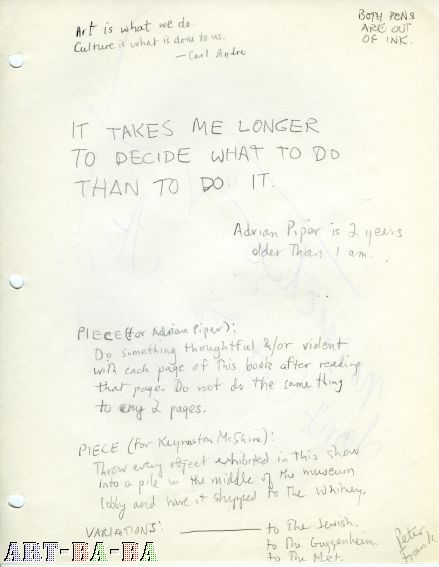
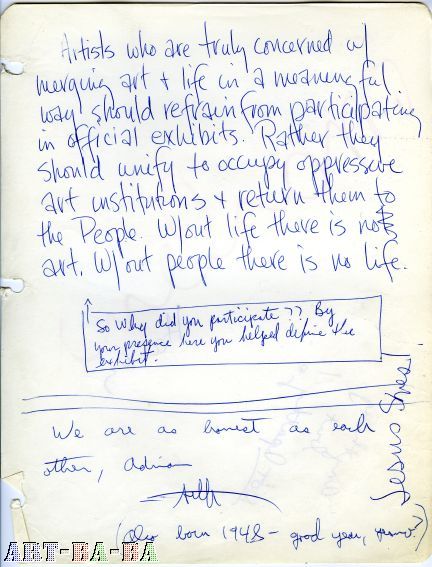

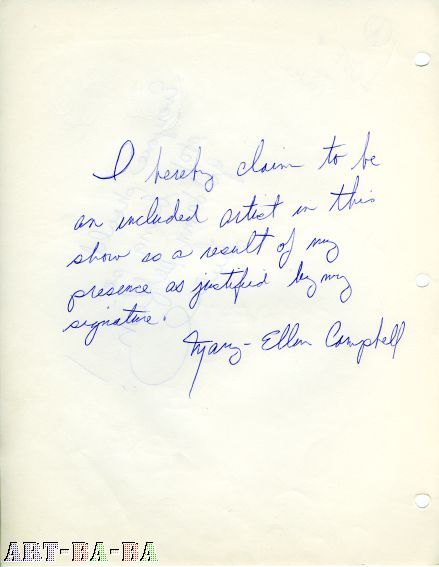
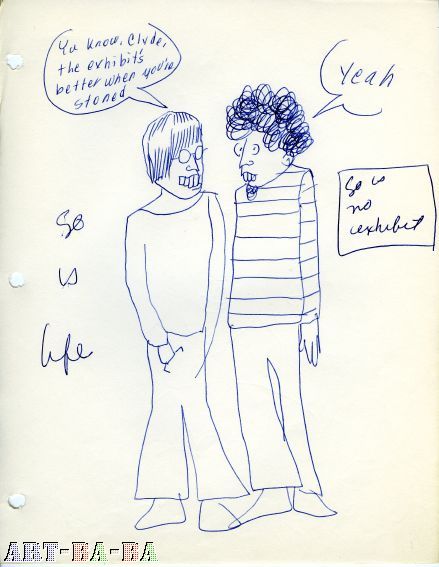

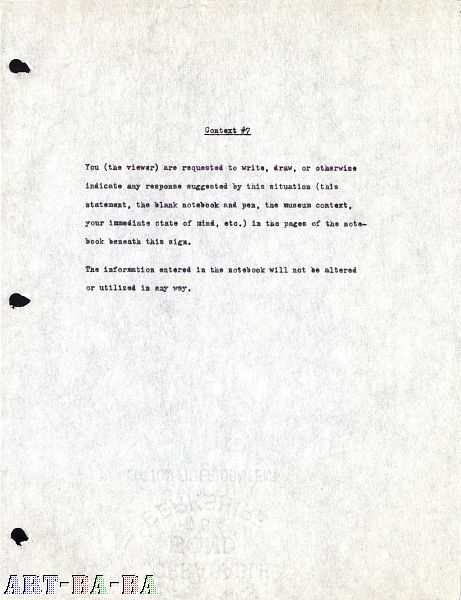
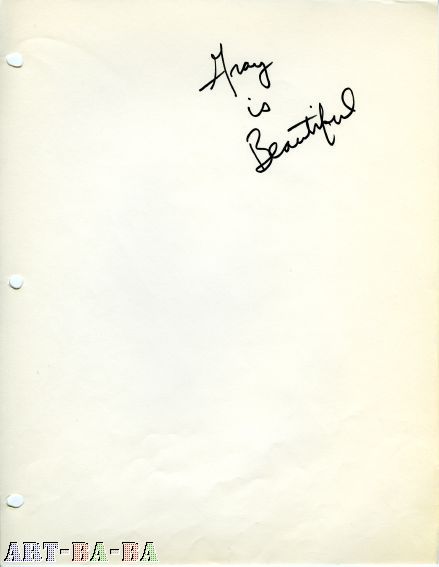
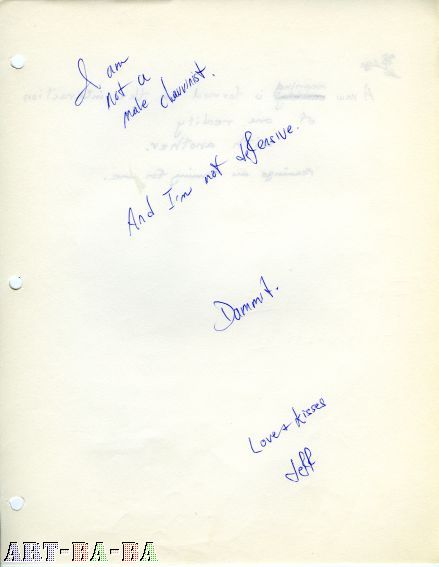
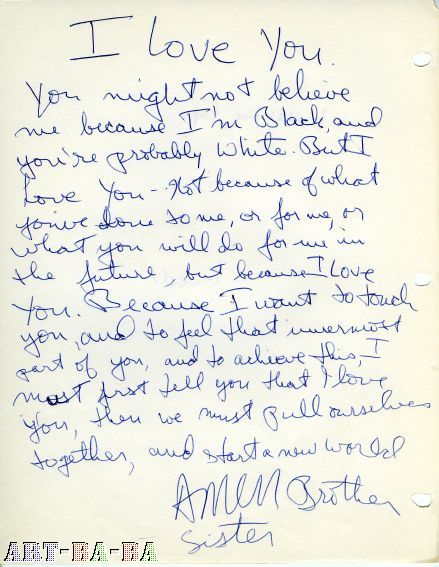

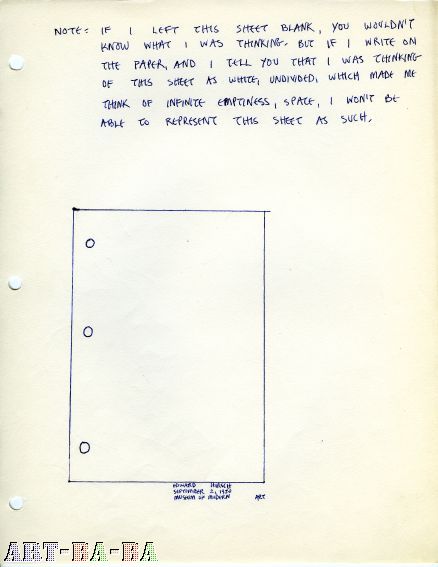


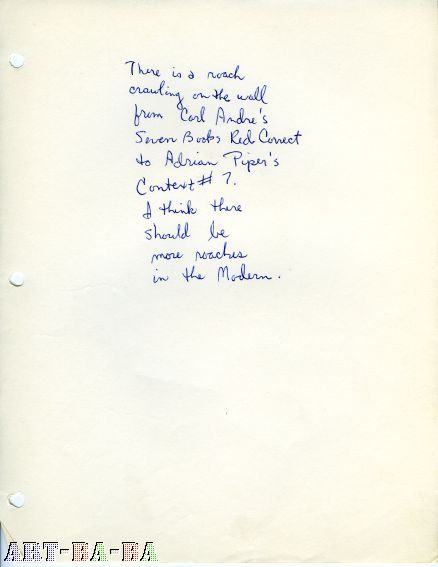
1970,综合材料装置(局部)
(1970; mixed media installation for the Museum of Modern Art Information Exhibition: seven black vinyl three-ring loose-leaf notebooks, 9”x12”x3” each, 8.5”x11” three-hole punch blank pages, ballpoint pen, frontispiece as sign mounted on wall).
Detail: Frontispiece
















The Mythic Being, Cycle I
神话类,循环 1
193-1974
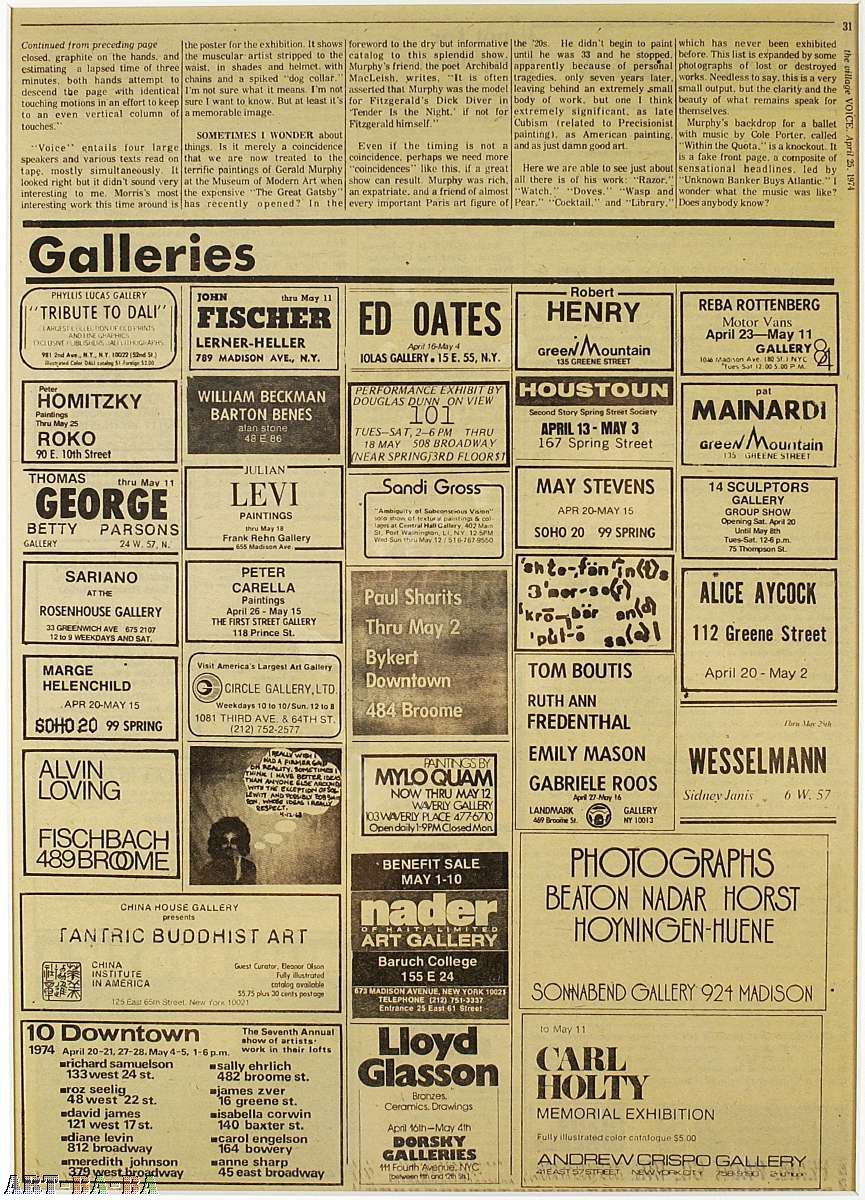
The Mythic Being, Cycle I: 9/21/61
(1973; Village Voice Ad 乡村之声, 14 x 17”)
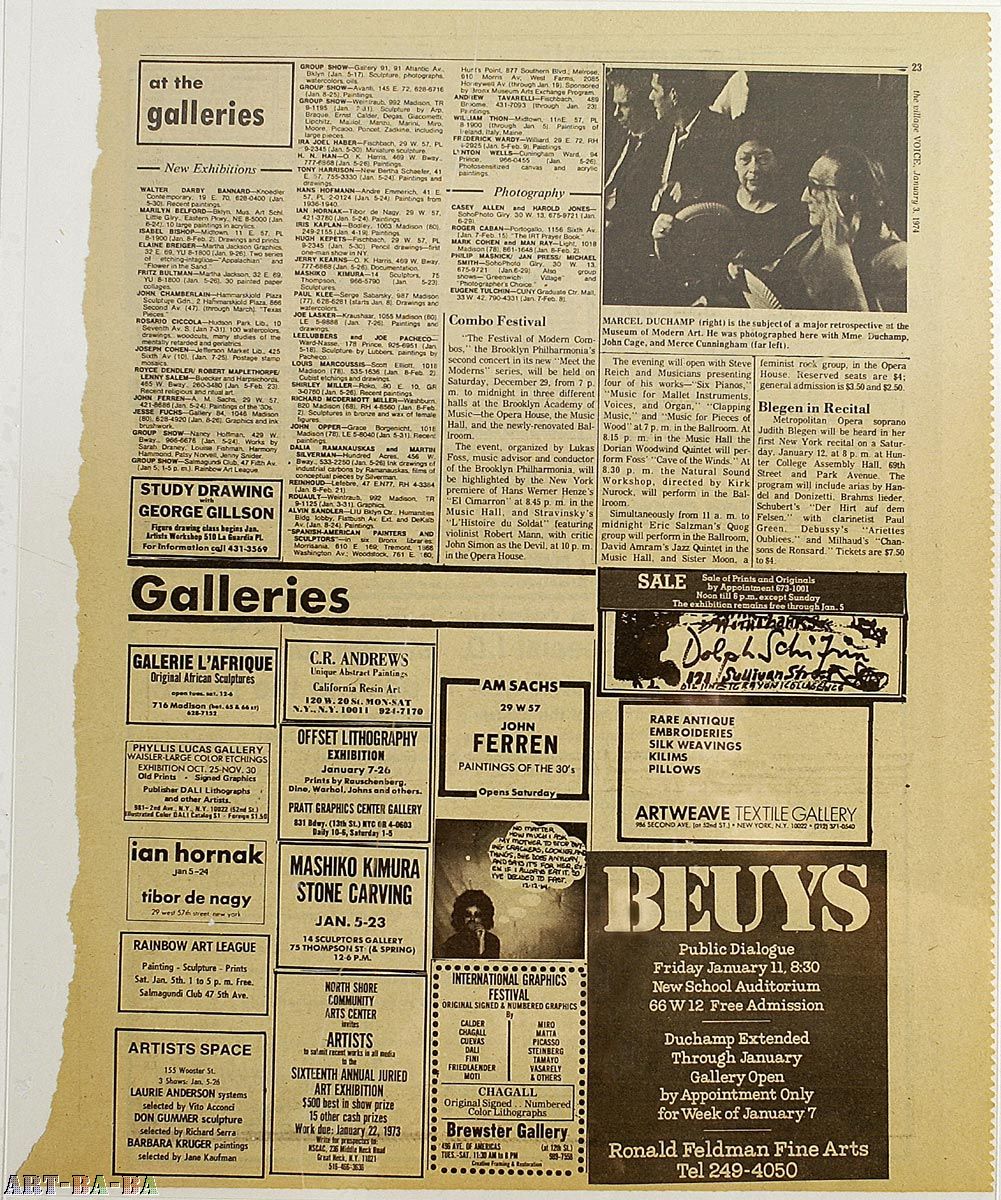
The Mythic Being, Cycle I: 4/12/68
(1974; Village Voice Ad 乡村之声, 14 x 17”)
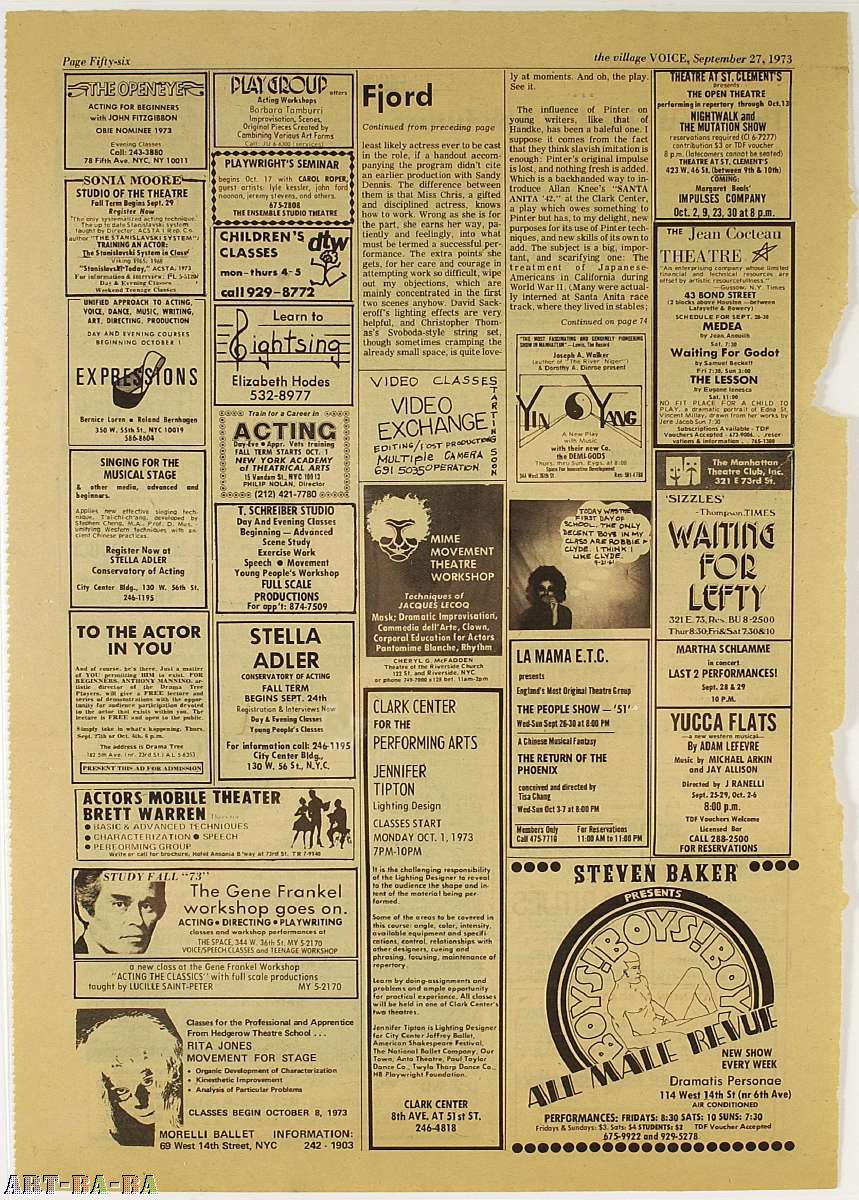
The Mythic Being, Cycle I: 12/12/64
(1974; Village Voice Ad 乡村之声, 14 x 17”)
神话类,循环 1
193-1974

The Mythic Being, Cycle I: 9/21/61
(1973; Village Voice Ad 乡村之声, 14 x 17”)

The Mythic Being, Cycle I: 4/12/68
(1974; Village Voice Ad 乡村之声, 14 x 17”)

The Mythic Being, Cycle I: 12/12/64
(1974; Village Voice Ad 乡村之声, 14 x 17”)
The Mythic Being: Let's Have a Talk
神话类:我们谈一下吧
海报,摄影上铅笔,1975

The Mythic Being: Let’s Have a Talk, #2 of 6
(1975; unique vintage poster from oil crayon drawing on photograph, 17.75” x 25.5”)

The Mythic Being: Let’s Have a Talk, #3 of 6
(1975; unique vintage poster from oil crayon drawing on photograph, 25.5” x 17.75”)
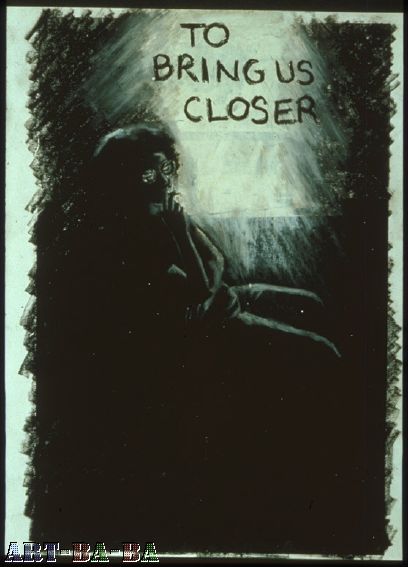
The Mythic Being: Let’s Have a Talk, #4 of 6
(1975; unique vintage poster from oil crayon drawing on photograph, 25.5” x 17.75”)

The Mythic Being: Let’s Have a Talk, #5 of 6
(1975; unique vintage poster from oil crayon drawing on photograph, 25.5” x 17.75”)
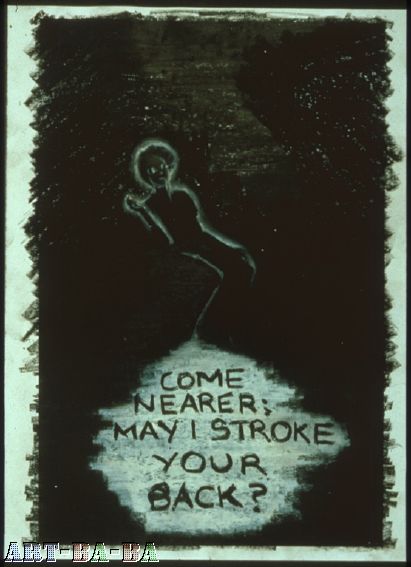
The Mythic Being: Let’s Have a Talk, #6 of 6
(1975; unique vintage poster from oil crayon drawing on photograph, 25.5” x 17.75”)
神话类:我们谈一下吧
海报,摄影上铅笔,1975

The Mythic Being: Let’s Have a Talk, #2 of 6
(1975; unique vintage poster from oil crayon drawing on photograph, 17.75” x 25.5”)

The Mythic Being: Let’s Have a Talk, #3 of 6
(1975; unique vintage poster from oil crayon drawing on photograph, 25.5” x 17.75”)

The Mythic Being: Let’s Have a Talk, #4 of 6
(1975; unique vintage poster from oil crayon drawing on photograph, 25.5” x 17.75”)

The Mythic Being: Let’s Have a Talk, #5 of 6
(1975; unique vintage poster from oil crayon drawing on photograph, 25.5” x 17.75”)

The Mythic Being: Let’s Have a Talk, #6 of 6
(1975; unique vintage poster from oil crayon drawing on photograph, 25.5” x 17.75”)
神话类:练瑜伽
黑白摄影
1975
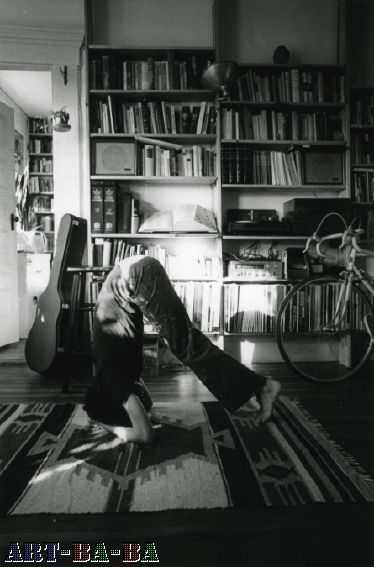
The Mythic Being: Doing Yoga #1 of 6
(1975; six 10 x 8” black and white vintage photographs)

The Mythic Being: Doing Yoga #2 of 6
(1975; six 10 x 8” black and white vintage photographs)

The Mythic Being: Doing Yoga #3 of 6
(1975; six 10 x 8” black and white vintage photographs)
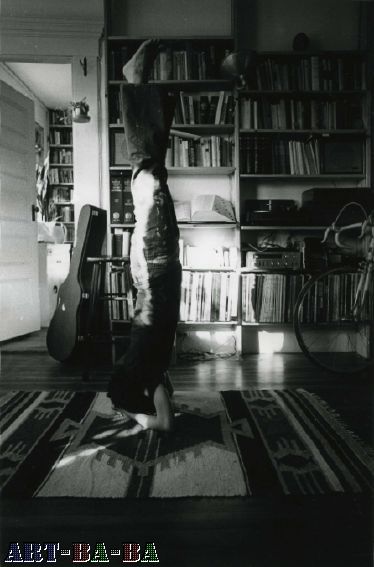
The Mythic Being: Doing Yoga #4 of 6
(1975; six 10 x 8” black and white vintage photographs)

The Mythic Being: Doing Yoga #5 of 6
(1975; six 10 x 8” black and white vintage photographs)
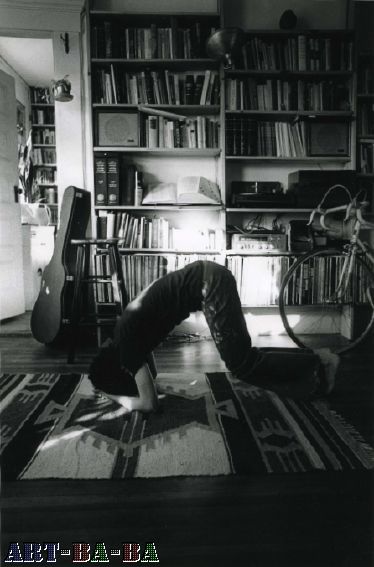
The Mythic Being: Doing Yoga #6 of 6
(1975; six 10 x 8” black and white vintage photographs)
黑白摄影
1975

The Mythic Being: Doing Yoga #1 of 6
(1975; six 10 x 8” black and white vintage photographs)

The Mythic Being: Doing Yoga #2 of 6
(1975; six 10 x 8” black and white vintage photographs)

The Mythic Being: Doing Yoga #3 of 6
(1975; six 10 x 8” black and white vintage photographs)

The Mythic Being: Doing Yoga #4 of 6
(1975; six 10 x 8” black and white vintage photographs)

The Mythic Being: Doing Yoga #5 of 6
(1975; six 10 x 8” black and white vintage photographs)

The Mythic Being: Doing Yoga #6 of 6
(1975; six 10 x 8” black and white vintage photographs)
It’s Just Art | 只是艺术
行为文献 1980
13张黑白摄影,8 x 10"
2张黑白摄影,10 x 8"
3个文字拼贴,8 x 10"
1980; performance documentation: 13 black & white photos with hand-lettered texts, 8 x 10”
2 black & white photos with hand-lettered texts, 10 x 8”
3 paper-text collages with hand-lettered texts, 8 x 10”
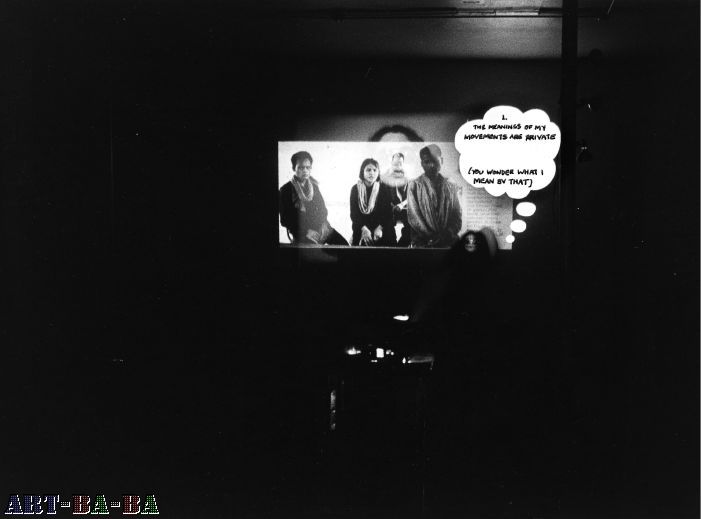
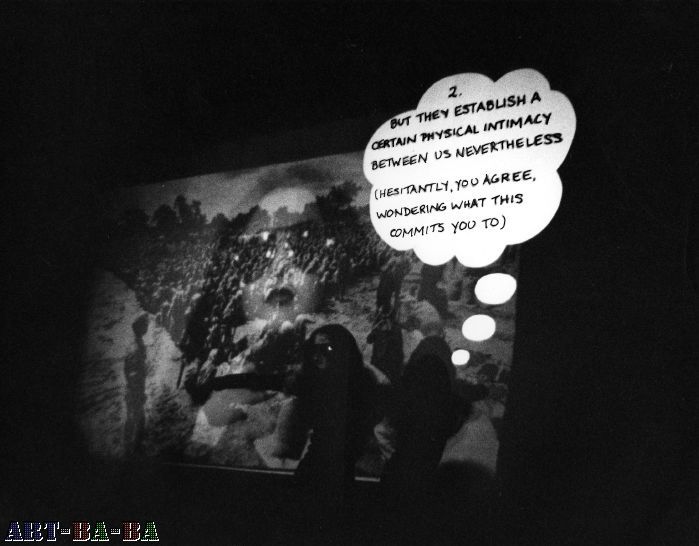
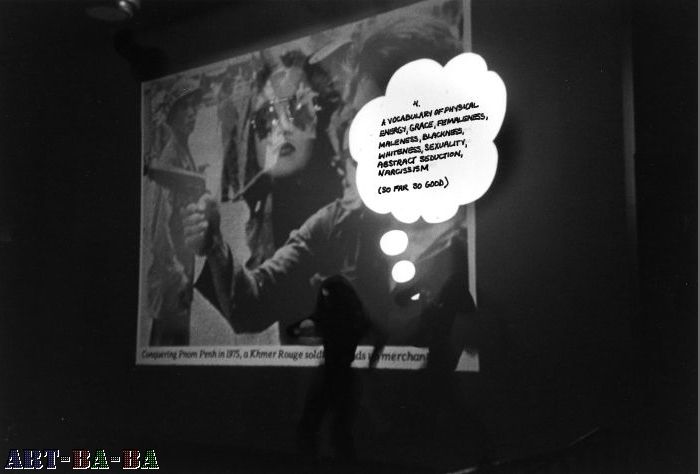
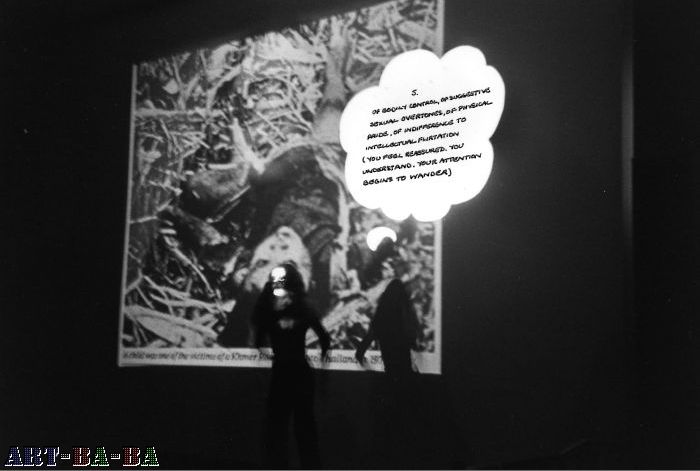
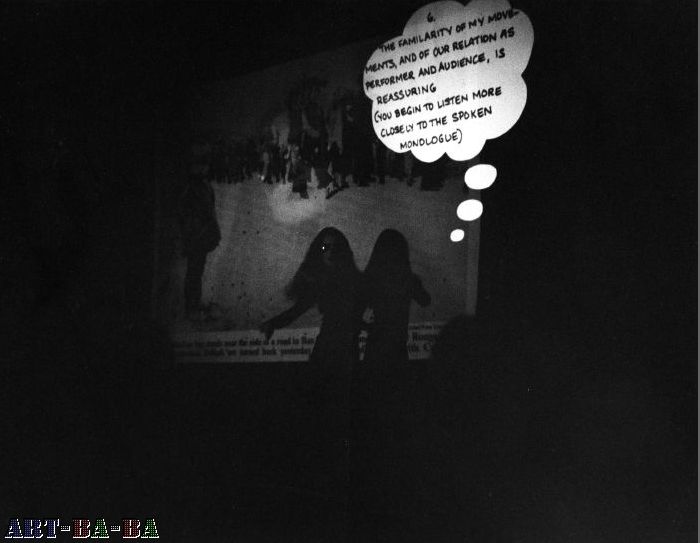

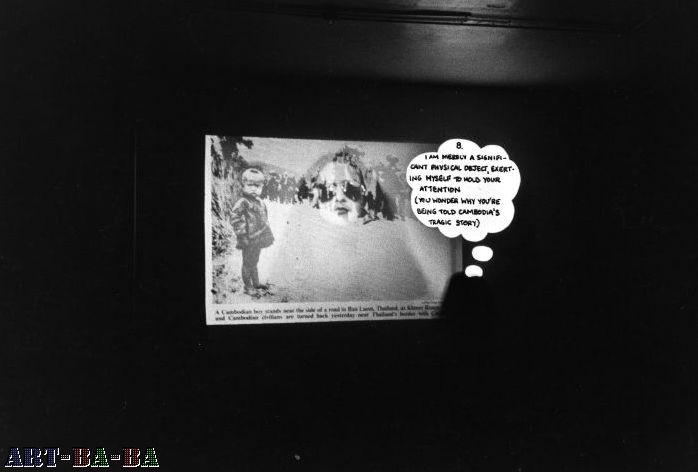
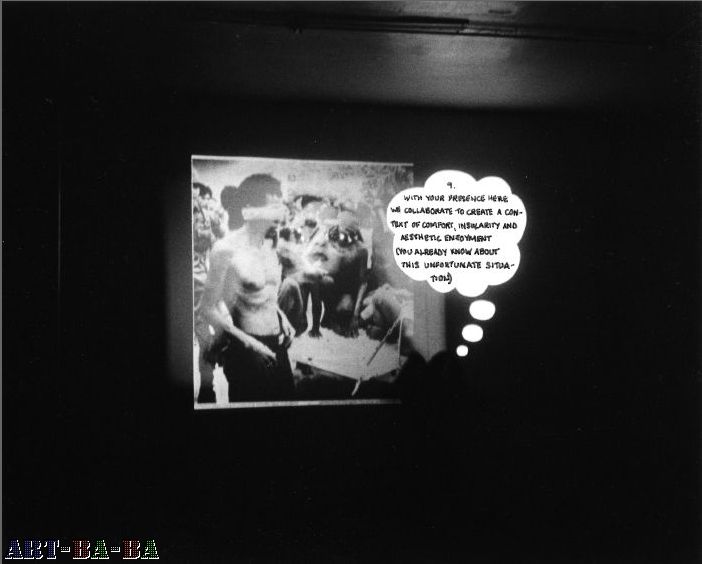
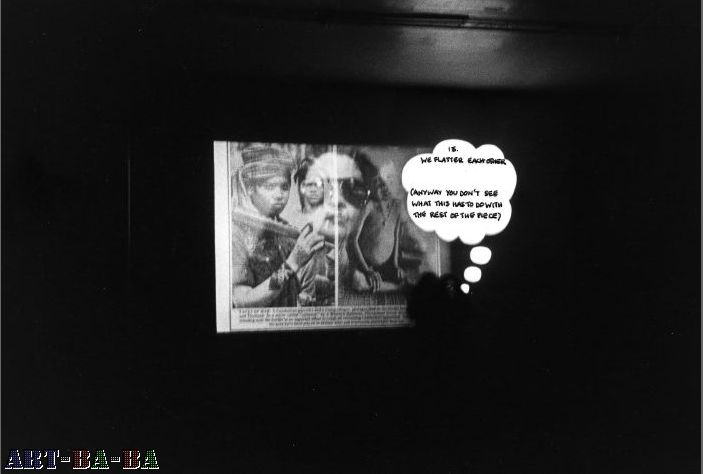
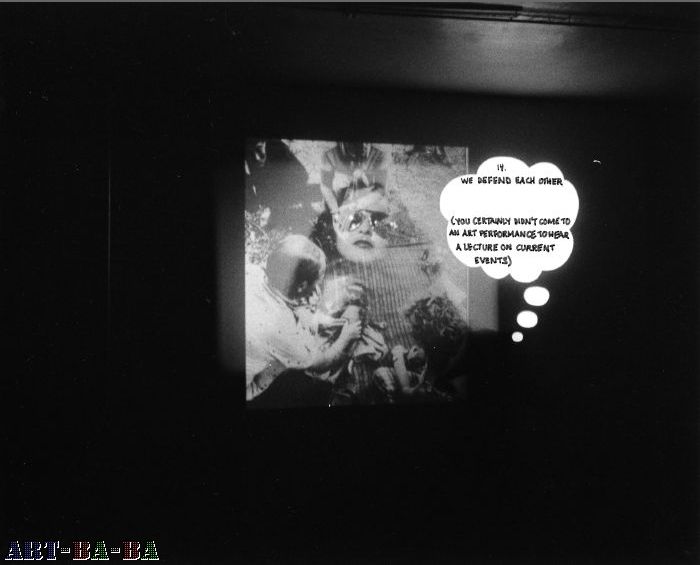
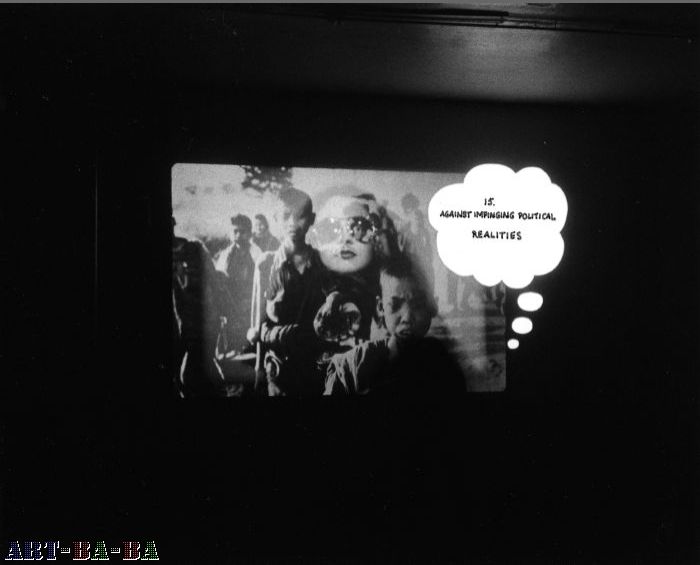
行为文献 1980
13张黑白摄影,8 x 10"
2张黑白摄影,10 x 8"
3个文字拼贴,8 x 10"
1980; performance documentation: 13 black & white photos with hand-lettered texts, 8 x 10”
2 black & white photos with hand-lettered texts, 10 x 8”
3 paper-text collages with hand-lettered texts, 8 x 10”











Portrait | 肖像
1983

所有意识物种都有一个攻击外来敌方的本能。有些物种也会攻击自己物种作为敌方。比如说,老鼠会互相之间攻击、杀、甚至于把对方吃掉以便解决过渡拥挤和损失问题。但人类有点特殊。只有人类有一种自我消灭、自杀的意识。
人类可能把自己看成外来敌人。他们可能认为如果让这个敌人存在的话,这个敌人会把他们消灭掉。以便消灭自己他们消灭自己。
All sentient species are biologically programmed to attack alien enemies. Some species are programmed to attack their own members as alien enemies. Rats, for example, will attack, kill, or even cannibalize one another under conditions of overcrowding and deprivation. But human beings are more unique still. Only human beings are capable of self-destruction, of suicide, of acts that have their own self-obliteration as a conscious purpose.
Human beings must view themselves as alien enemies to be able to do this. They must believe that if they allow this alien enemy to exist, it will destroy them. And so to avoid destroying themselves they destroy themselves.
We can see why this might be so. We do not know ourselves very well. Often we feel assaulted by unacceptable thoughts and impulses, and move to suppress them; or shamed by unacceptable physical features, and work to remove them; or threatened by others’ unacceptable behavior or appearance, and to attack or reject them. We view these things as alien enemies, not as the familiar ingrained parts of ourselves they are. And so we are constantly moved to destroy and reconstitute ourselves in conformity with our truncated and distorted self-image.
In all these case, and others like them, we fail to recognize that we are destroying ourselves. And so our centrally motivating urge to self-destruction itself goes unrecognized. Perhaps we wouldn’t recognize this particular facet of ourselves if it stared us in the face.
© Adrian Piper 1983
1983

所有意识物种都有一个攻击外来敌方的本能。有些物种也会攻击自己物种作为敌方。比如说,老鼠会互相之间攻击、杀、甚至于把对方吃掉以便解决过渡拥挤和损失问题。但人类有点特殊。只有人类有一种自我消灭、自杀的意识。
人类可能把自己看成外来敌人。他们可能认为如果让这个敌人存在的话,这个敌人会把他们消灭掉。以便消灭自己他们消灭自己。
All sentient species are biologically programmed to attack alien enemies. Some species are programmed to attack their own members as alien enemies. Rats, for example, will attack, kill, or even cannibalize one another under conditions of overcrowding and deprivation. But human beings are more unique still. Only human beings are capable of self-destruction, of suicide, of acts that have their own self-obliteration as a conscious purpose.
Human beings must view themselves as alien enemies to be able to do this. They must believe that if they allow this alien enemy to exist, it will destroy them. And so to avoid destroying themselves they destroy themselves.
We can see why this might be so. We do not know ourselves very well. Often we feel assaulted by unacceptable thoughts and impulses, and move to suppress them; or shamed by unacceptable physical features, and work to remove them; or threatened by others’ unacceptable behavior or appearance, and to attack or reject them. We view these things as alien enemies, not as the familiar ingrained parts of ourselves they are. And so we are constantly moved to destroy and reconstitute ourselves in conformity with our truncated and distorted self-image.
In all these case, and others like them, we fail to recognize that we are destroying ourselves. And so our centrally motivating urge to self-destruction itself goes unrecognized. Perhaps we wouldn’t recognize this particular facet of ourselves if it stared us in the face.
© Adrian Piper 1983
Vanilla Nightmares #13 | 香草恶梦
1986
charcoal & oil crayon drawing on newsprint, 22 x 13.75”
报纸上铅笔绘画,22 x 13.75"
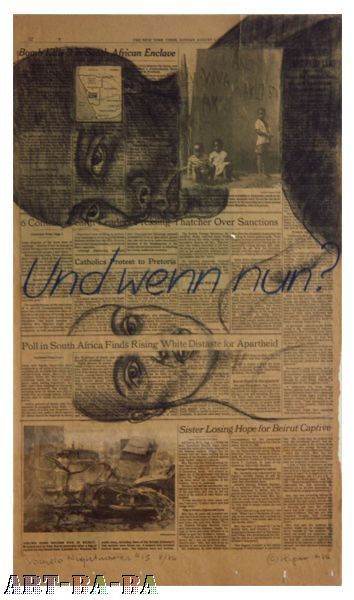
1986
charcoal & oil crayon drawing on newsprint, 22 x 13.75”
报纸上铅笔绘画,22 x 13.75"

The Big Four-Oh | 四巨头-噢
录像装置
1988

47分48秒循环播放,文献,桌子,笔记本,容器跟尿、醋、血、汗、眼泪
1988, video installation: enclosed room, 47:48 minute endless loop DVD endurance piece documentation, video monitor, table, open 8.5 x 5.5 black vinyl notebook journal w/ handwritten text, suit of armor, 40 hardballs, sealed jars of piss, vinegar, blood, sweat and tears; dimensions variable
请点击这里观看录像片段
Safe | 安全
综合材料装置
1990
四张放大的杂志摄影跟丝印的文字。
1990; mixed-media installation: 4 enlarged magazine photographs with silkscreened texts mounted in four corners of room plus endless loop audio soundtrack
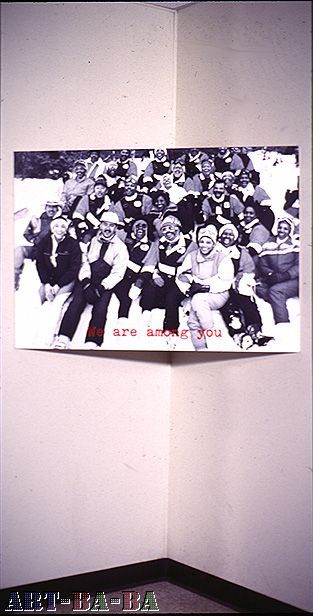
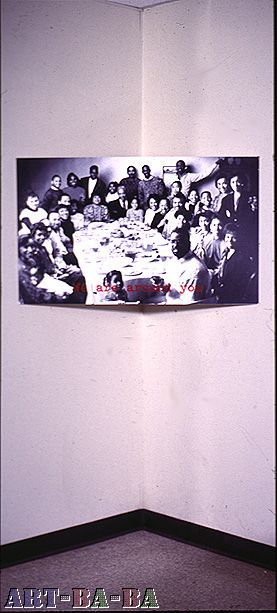

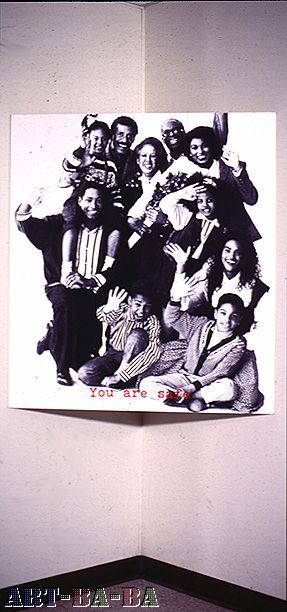 、
、
综合材料装置
1990
四张放大的杂志摄影跟丝印的文字。
1990; mixed-media installation: 4 enlarged magazine photographs with silkscreened texts mounted in four corners of room plus endless loop audio soundtrack



 、
、
Vote/Emote | 投票/Emote
综合材料装置
1990
(1990; mixed media installation: 4 wooden cubicles, 4 lightbox windows, 4 black vinyl looseleaf binders w/pre-printed paper, 4 pens. 84 x 164.5 x 48.75”)
Vote/Emote

Notebook #1, pre-printed header:
1. List your fears of what we might know about you:
笔记本#1:
1. 列一下你怕我们知道关于你的秘密
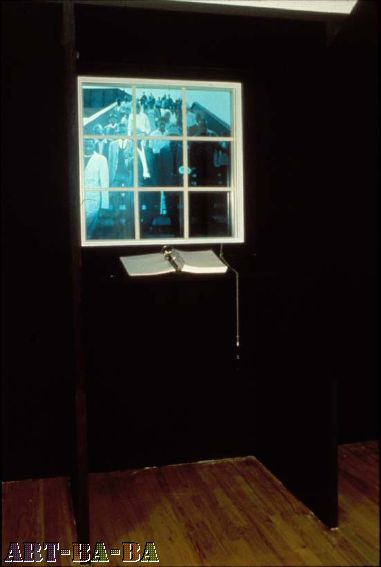
Notebook #2, pre-printed header:
2. List your fears of what we might think of you:
笔记本2#
2. 列一下你怕我们可能对你有的看法
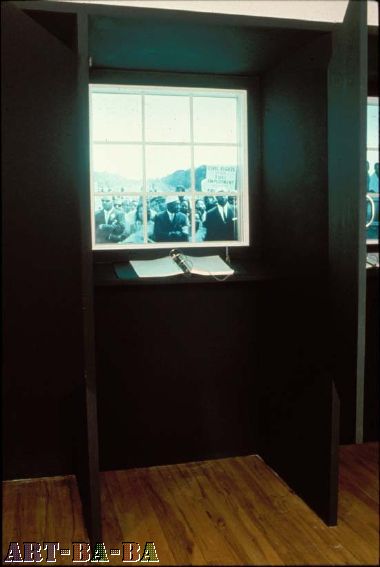
Notebook #3, pre-printed header:
3. List your fears of how we might treat you:
笔记本#3
3. 列一下你怕我们对你可能会有的态度
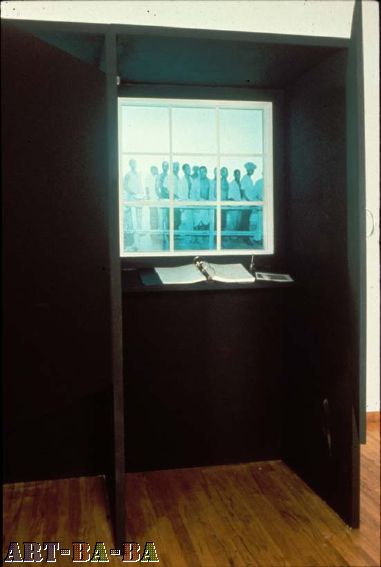
Notebook #4, pre-printed header:
4. List your fears of what we might do with your accumulations:
综合材料装置
1990
(1990; mixed media installation: 4 wooden cubicles, 4 lightbox windows, 4 black vinyl looseleaf binders w/pre-printed paper, 4 pens. 84 x 164.5 x 48.75”)
Vote/Emote

Notebook #1, pre-printed header:
1. List your fears of what we might know about you:
笔记本#1:
1. 列一下你怕我们知道关于你的秘密

Notebook #2, pre-printed header:
2. List your fears of what we might think of you:
笔记本2#
2. 列一下你怕我们可能对你有的看法

Notebook #3, pre-printed header:
3. List your fears of how we might treat you:
笔记本#3
3. 列一下你怕我们对你可能会有的态度

Notebook #4, pre-printed header:
4. List your fears of what we might do with your accumulations:
What It’s Like, What It Is #3 | 像什么,是什么 #3
录像装置
1991
纽约现代美术馆
灯光、镜子、4个录像
What It’s Like, What It Is #3
(1991; constructed environment video installation for the Museum of Modern Art, N.Y.: lights, mirrors, four video disks with music soundtrack) View #1
Photos: David Campos for the Museum of Contemporary Art of Barcelona


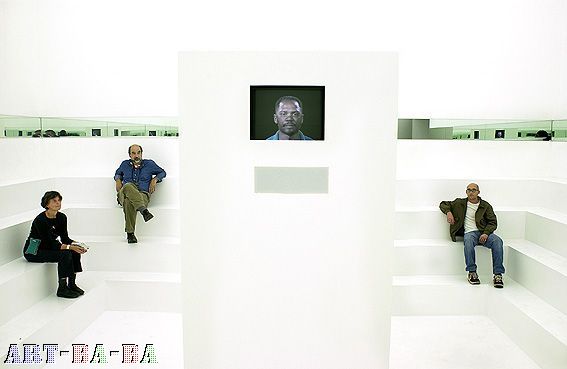
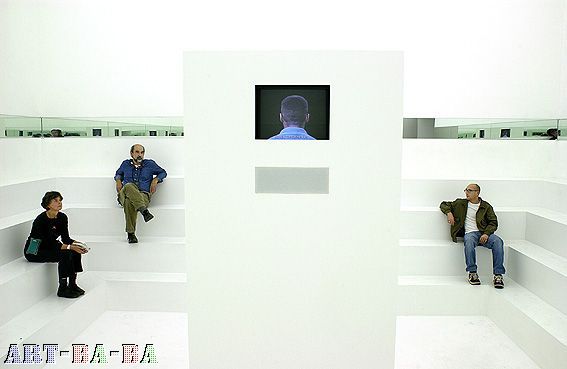
请点击这里观看现代美术馆展览现场
Decide Who You Are, #1: Skinned Alive |决定你是谁#1:活活地将皮剥下
丝印摄影、丝印文字
1992
(1992; three silk-screened photos, graph paper, silk-screened pencil drawing, two silk-screened texts, 72 x 153”)
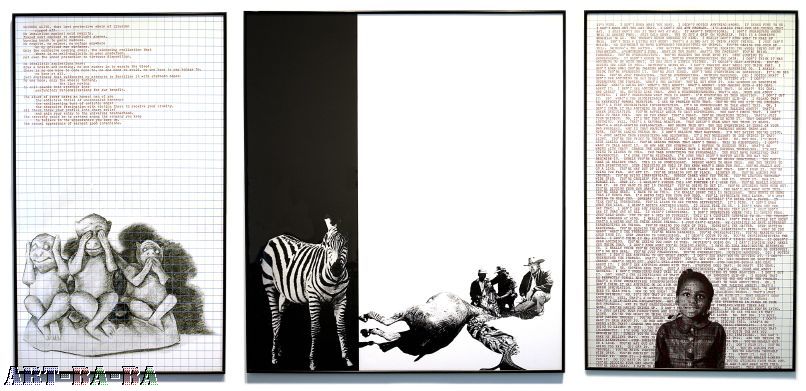
左边文字:
Left-hand panel text:
SKINNED ALIVE, that last protective skein of illusion
ripped off.
No insulation against acid reality,
flayed meat exposed to searchlight glares,
burning harsh to panic madness.
No respite, no solace, no refuge anywhere
on my grilled raw surfaces.
Only the corrosive cooking smell, the sickening realization that
there is no self-duplicity in your predation,
not even the inner pretension to virtuous disposition.
No idealistic aspirations here;
draw a breath and nothing, no one rushes in to aerate the blood.
There is no one home to come home to, no one home to avoid, no one home to pay homage to,
no home at all,
just emptiness that suffocates my attempts to fertilize it with stubborn hopes.
No one home, only the wheels turning,
the lips moving
to emit sounds that assemble into
perfunctory rationalizations for our benefit.
The abuse of power makes an honest man of you
the addictive thrill of unconcealed contempt
the exhilarating buzz of sadistic anger
the obsessive fascination with victims there to receive your cruelty,
all these throw your profile into sharp relief
and gain your entry to the universal brotherhood.
The travesty would be to pretend among the company you keep
to believe in the appearances you keep up,
the casual appearance of earnest good intentions.
右边文字:
Right-hand panel text:
IT'S FINE. I DON'T KNOW WHAT YOU MEAN. I DIDN'T NOTICE ANYTHING WRONG. IT SEEMS FINE TO ME. I DON'T KNOW WHY YOU SAY THAT. I DON'T SEE ANY PROBLEM. I'M AMAZED THAT YOU SEE THINGS THAT WAY. I JUST DON'T SEE IT THAT WAY AT ALL. IT WASN'T INTENTIONAL. I DON'T UNDERSTAND WHERE THIS IS COMING FROM. JUST CALM DOWN. TRY TO GET A GRIP ON YOURSELF. THIS IS A COMPLETE SURPRISE TO ME. THE THOUGHT NEVER CROSSED MY MIND. I REALLY DON'T KNOW WHAT TO MAKE OF THIS. ISN'T THIS A LITTLE BIT MUCH? THAT'S A WEIRD WAY TO THINK ABOUT THINGS. I JUST CAN'T RELATE. WE CERTAINLY DO HAVE DIFFERENT PERSPECTIVES ON THINGS. YOU'RE MAKING TOO MUCH OF THIS. NOTHING'S THE MATTER. STOP GETTING EMOTIONAL. YOU'RE BLOWING THE WHOLE THING OUT OF PROPORTION. EVERYTHING'S FINE. WHAT DO YOU MEAN? WHAT'S THE PROBLEM? YOU'RE BEING PARANOID. YOU'RE OVERSENSITIVE. YOU'RE READING TOO MUCH INTO IT. STOP JUMPING TO CONCLUSIONS. IT DIDN'T OCCUR TO ME. YOU'RE OVERINTERPRETING THE DATA. I DON'T THINK IT HAS ANYTHING TO DO WITH THAT. IT WAS JUST A SIMPLE MISTAKE. IT DOESN'T MEAN ANYTHING. YOU'RE SEEING TOO MUCH IN THIS. NOTHING'S GOING ON. I CAN'T IMAGINE WHAT MAKES YOU THINK THAT. I DON'T KNOW WHAT YOU'RE TALKING ABOUT. I HAVE NO IDEA WHAT YOU'RE REFERRING TO. I REALLY THINK YOU'RE OVERDOING IT. YOU'RE JUST TIRED. DON'T TAKE EVERYTHING SO SERIOUSLY. IT'S NO BIG DEAL. YOU'RE JUST PROJECTING. YOU'RE OVERREACTING. NOTHING HAPPENED. DID I NOTICE WHAT? I DON'T SEE ANYTHING TO GET UPSET ABOUT. I DON'T SEE WHAT YOU'RE GETTING AT. I DON'T UNDERSTAND THE PROBLEM. WHAT'S THE MATTER? YOU'LL GET OVER IT. DID SOMEONE DO SOMETHING WRONG? WHAT'S GOING ON? WHAT'S THIS ABOUT? WHAT'S WRONG? STOP MAKING SUCH A BIG DEAL ABOUT IT. I DON'T SEE ANYTHING WRONG WITH THAT. EVERYONE DOES THAT. SO WHAT? BIG DEAL. WHO CARES? NO, NOTHING LIKE THAT. JUST A MISUNDERSTANDING, THAT'S ALL. MUCH ADO ABOUT NOTHING. I DON'T UNDERSTAND WHAT THIS IS ABOUT. I'M MYSTIFIED BY YOUR REACTION. I DON'T GET IT. SO? WHAT'S THE SIGNIFICANCE OF THAT? IT WAS JUST AN INNOCENT SLIP-UP. I REGARD THAT AS PERFECTLY NORMAL BEHAVIOR. I SEE NO PROBLEM WITH THAT. YOU'RE THE ONE WITH THE PROBLEM. THAT'S A VERY UNCHARITABLE INTERPRETATION. IT'S SO UNNECESSARY TO TALK ABOUT THIS. OH, I DON'T THINK IT HAS ANYTHING TO DO WITH THAT, REALLY. WHAT ARE YOU TALKING ABOUT? THAT'S SHEER SPECULATION. YOU'RE AWFULLY QUICK TO CAST ASPERSIONS. YOU CAN'T PROVE THAT. I DON'T NEED TO HEAR THIS. HOW DO YOU KNOW? THAT'S CRAZY. YOU'RE IMAGINING THINGS. THAT'S JUST YOUR OPINION. NO, IT'S NOT THAT AT ALL. THAT HAS NOTHING TO DO WITH IT. THAT DOESN'T MEAN ANYTHING. WELL, THAT'S A NATURAL REACTION. THAT DOESN'T MEAN WHAT YOU THINK IT MEANS. THAT'S A SELF-SERVING EXPLANATION. WHY BRING THIS UP? YOU SEE EVERYTHING IN TERMS OF YOUR OWN PROBLEMS. WHY IS THAT OBJECTIONABLE? YOU'RE COOKING UP PROBLEMS WHERE THERE ARE NONE. YOU'RE MAKING THINGS UP. I DON'T BELIEVE THAT HAPPENED. I'M NOT SAYING YOU'RE LYING, I'M JUST SAYING YOUR PERCEPTIONS ARE DISTORTED. IT'S NOT NECESSARY TO SEE THINGS IN THAT LIGHT. YOU'RE TOO UPSET TO THINK CLEARLY. WE'LL DISCUSS IT LATER. NO, NOT NOW, I'M BUSY. STOP MAKING TROUBLE. YOU'RE SEEING THINGS THAT AREN'T THERE. THIS IS RIDICULOUS. I DON'T WANT TO TALK ABOUT IT. SO HOW ARE YOU OTHERWISE? I REFUSE TO DISCUSS THIS. WHAT'S SO WRONG WITH THAT? CHANGE THE SUBJECT. PEOPLE HAVE A RIGHT TO EXPRESS THEMSELVES. I'M NOT GOING TO LISTEN TO THIS. YOU TAKE EVERYTHING TOO PERSONALLY. YOU MUST HAVE PERCEIVED THAT INCORRECTLY. I'M SURE YOU'RE MISTAKEN. I'M SURE THAT DIDN'T HAPPEN QUITE THE WAY YOU DESCRIBE IT. SURELY YOU'RE EXAGGERATING JUST A LITTLE. YOU'RE BEING IRRATIONAL. YOU CAN'T MAKE ME BELIEVE THAT. THIS IS SO UNNECESSARY. NOBODY WANTS TO HEAR THIS. ARE YOU TRYING TO RUIN EVERYTHING? STOP INSISTING ON THIS IF YOU KNOW WHAT'S GOOD FOR YOU. YOU'RE REALLY OUT ON A LIMB. YOU'RE WAY OUT OF LINE. IT'S NOT YOUR PLACE TO SAY THAT. DON'T PUSH IT. YOU'RE GOING TOO FAR. GET OFF IT. YOU'RE SPEAKING OUT OF PLACE. LIGHTEN UP. YOU'RE ASKING FOR TROUBLE. YOU'RE BEING INAPPROPRIATE. NOBODY CARES WHAT YOU THINK. YOU'RE LEAVING YOURSELF WIDE OPEN. YOU'RE CRUISIN' FOR A BRUISIN'. PUT A LID ON IT. CAN IT. STUFF IT. BAG IT. FORGET IT. DROP IT. I WOULDN'T PURSUE THIS ANY FURTHER IF I WERE YOU. YOU'RE REALLY ASKING FOR IT. DO YOU WANT TO GET IN TROUBLE? YOU'RE GOING TO GET IT. YOU'RE STICKING YOUR NECK OUT. YOU'RE DIGGING YOUR OWN GRAVE. A REAL GLUTTON FOR PUNISHMENT. YOU CAN'T GET AWAY WITH THIS. YOU'RE DEAD MEAT. I HATE TO DO THIS. I'M REALLY SORRY THIS IS NECESSARY. THIS HURTS ME MORE THAN IT HURTS YOU. I'M DOING THIS FOR YOUR OWN GOOD. YOU'LL APPRECIATE THIS LATER. I'M JUST TRYING TO HELP YOU. SOMEDAY YOU'LL THANK ME FOR THIS. ACTUALLY I'M DOING YOU A FAVOR. IN TIME YOU'LL UNDERSTAND. YOU'LL LEARN TO SEE THINGS DIFFERENTLY.
丝印摄影、丝印文字
1992
(1992; three silk-screened photos, graph paper, silk-screened pencil drawing, two silk-screened texts, 72 x 153”)

左边文字:
Left-hand panel text:
SKINNED ALIVE, that last protective skein of illusion
ripped off.
No insulation against acid reality,
flayed meat exposed to searchlight glares,
burning harsh to panic madness.
No respite, no solace, no refuge anywhere
on my grilled raw surfaces.
Only the corrosive cooking smell, the sickening realization that
there is no self-duplicity in your predation,
not even the inner pretension to virtuous disposition.
No idealistic aspirations here;
draw a breath and nothing, no one rushes in to aerate the blood.
There is no one home to come home to, no one home to avoid, no one home to pay homage to,
no home at all,
just emptiness that suffocates my attempts to fertilize it with stubborn hopes.
No one home, only the wheels turning,
the lips moving
to emit sounds that assemble into
perfunctory rationalizations for our benefit.
The abuse of power makes an honest man of you
the addictive thrill of unconcealed contempt
the exhilarating buzz of sadistic anger
the obsessive fascination with victims there to receive your cruelty,
all these throw your profile into sharp relief
and gain your entry to the universal brotherhood.
The travesty would be to pretend among the company you keep
to believe in the appearances you keep up,
the casual appearance of earnest good intentions.
右边文字:
Right-hand panel text:
IT'S FINE. I DON'T KNOW WHAT YOU MEAN. I DIDN'T NOTICE ANYTHING WRONG. IT SEEMS FINE TO ME. I DON'T KNOW WHY YOU SAY THAT. I DON'T SEE ANY PROBLEM. I'M AMAZED THAT YOU SEE THINGS THAT WAY. I JUST DON'T SEE IT THAT WAY AT ALL. IT WASN'T INTENTIONAL. I DON'T UNDERSTAND WHERE THIS IS COMING FROM. JUST CALM DOWN. TRY TO GET A GRIP ON YOURSELF. THIS IS A COMPLETE SURPRISE TO ME. THE THOUGHT NEVER CROSSED MY MIND. I REALLY DON'T KNOW WHAT TO MAKE OF THIS. ISN'T THIS A LITTLE BIT MUCH? THAT'S A WEIRD WAY TO THINK ABOUT THINGS. I JUST CAN'T RELATE. WE CERTAINLY DO HAVE DIFFERENT PERSPECTIVES ON THINGS. YOU'RE MAKING TOO MUCH OF THIS. NOTHING'S THE MATTER. STOP GETTING EMOTIONAL. YOU'RE BLOWING THE WHOLE THING OUT OF PROPORTION. EVERYTHING'S FINE. WHAT DO YOU MEAN? WHAT'S THE PROBLEM? YOU'RE BEING PARANOID. YOU'RE OVERSENSITIVE. YOU'RE READING TOO MUCH INTO IT. STOP JUMPING TO CONCLUSIONS. IT DIDN'T OCCUR TO ME. YOU'RE OVERINTERPRETING THE DATA. I DON'T THINK IT HAS ANYTHING TO DO WITH THAT. IT WAS JUST A SIMPLE MISTAKE. IT DOESN'T MEAN ANYTHING. YOU'RE SEEING TOO MUCH IN THIS. NOTHING'S GOING ON. I CAN'T IMAGINE WHAT MAKES YOU THINK THAT. I DON'T KNOW WHAT YOU'RE TALKING ABOUT. I HAVE NO IDEA WHAT YOU'RE REFERRING TO. I REALLY THINK YOU'RE OVERDOING IT. YOU'RE JUST TIRED. DON'T TAKE EVERYTHING SO SERIOUSLY. IT'S NO BIG DEAL. YOU'RE JUST PROJECTING. YOU'RE OVERREACTING. NOTHING HAPPENED. DID I NOTICE WHAT? I DON'T SEE ANYTHING TO GET UPSET ABOUT. I DON'T SEE WHAT YOU'RE GETTING AT. I DON'T UNDERSTAND THE PROBLEM. WHAT'S THE MATTER? YOU'LL GET OVER IT. DID SOMEONE DO SOMETHING WRONG? WHAT'S GOING ON? WHAT'S THIS ABOUT? WHAT'S WRONG? STOP MAKING SUCH A BIG DEAL ABOUT IT. I DON'T SEE ANYTHING WRONG WITH THAT. EVERYONE DOES THAT. SO WHAT? BIG DEAL. WHO CARES? NO, NOTHING LIKE THAT. JUST A MISUNDERSTANDING, THAT'S ALL. MUCH ADO ABOUT NOTHING. I DON'T UNDERSTAND WHAT THIS IS ABOUT. I'M MYSTIFIED BY YOUR REACTION. I DON'T GET IT. SO? WHAT'S THE SIGNIFICANCE OF THAT? IT WAS JUST AN INNOCENT SLIP-UP. I REGARD THAT AS PERFECTLY NORMAL BEHAVIOR. I SEE NO PROBLEM WITH THAT. YOU'RE THE ONE WITH THE PROBLEM. THAT'S A VERY UNCHARITABLE INTERPRETATION. IT'S SO UNNECESSARY TO TALK ABOUT THIS. OH, I DON'T THINK IT HAS ANYTHING TO DO WITH THAT, REALLY. WHAT ARE YOU TALKING ABOUT? THAT'S SHEER SPECULATION. YOU'RE AWFULLY QUICK TO CAST ASPERSIONS. YOU CAN'T PROVE THAT. I DON'T NEED TO HEAR THIS. HOW DO YOU KNOW? THAT'S CRAZY. YOU'RE IMAGINING THINGS. THAT'S JUST YOUR OPINION. NO, IT'S NOT THAT AT ALL. THAT HAS NOTHING TO DO WITH IT. THAT DOESN'T MEAN ANYTHING. WELL, THAT'S A NATURAL REACTION. THAT DOESN'T MEAN WHAT YOU THINK IT MEANS. THAT'S A SELF-SERVING EXPLANATION. WHY BRING THIS UP? YOU SEE EVERYTHING IN TERMS OF YOUR OWN PROBLEMS. WHY IS THAT OBJECTIONABLE? YOU'RE COOKING UP PROBLEMS WHERE THERE ARE NONE. YOU'RE MAKING THINGS UP. I DON'T BELIEVE THAT HAPPENED. I'M NOT SAYING YOU'RE LYING, I'M JUST SAYING YOUR PERCEPTIONS ARE DISTORTED. IT'S NOT NECESSARY TO SEE THINGS IN THAT LIGHT. YOU'RE TOO UPSET TO THINK CLEARLY. WE'LL DISCUSS IT LATER. NO, NOT NOW, I'M BUSY. STOP MAKING TROUBLE. YOU'RE SEEING THINGS THAT AREN'T THERE. THIS IS RIDICULOUS. I DON'T WANT TO TALK ABOUT IT. SO HOW ARE YOU OTHERWISE? I REFUSE TO DISCUSS THIS. WHAT'S SO WRONG WITH THAT? CHANGE THE SUBJECT. PEOPLE HAVE A RIGHT TO EXPRESS THEMSELVES. I'M NOT GOING TO LISTEN TO THIS. YOU TAKE EVERYTHING TOO PERSONALLY. YOU MUST HAVE PERCEIVED THAT INCORRECTLY. I'M SURE YOU'RE MISTAKEN. I'M SURE THAT DIDN'T HAPPEN QUITE THE WAY YOU DESCRIBE IT. SURELY YOU'RE EXAGGERATING JUST A LITTLE. YOU'RE BEING IRRATIONAL. YOU CAN'T MAKE ME BELIEVE THAT. THIS IS SO UNNECESSARY. NOBODY WANTS TO HEAR THIS. ARE YOU TRYING TO RUIN EVERYTHING? STOP INSISTING ON THIS IF YOU KNOW WHAT'S GOOD FOR YOU. YOU'RE REALLY OUT ON A LIMB. YOU'RE WAY OUT OF LINE. IT'S NOT YOUR PLACE TO SAY THAT. DON'T PUSH IT. YOU'RE GOING TOO FAR. GET OFF IT. YOU'RE SPEAKING OUT OF PLACE. LIGHTEN UP. YOU'RE ASKING FOR TROUBLE. YOU'RE BEING INAPPROPRIATE. NOBODY CARES WHAT YOU THINK. YOU'RE LEAVING YOURSELF WIDE OPEN. YOU'RE CRUISIN' FOR A BRUISIN'. PUT A LID ON IT. CAN IT. STUFF IT. BAG IT. FORGET IT. DROP IT. I WOULDN'T PURSUE THIS ANY FURTHER IF I WERE YOU. YOU'RE REALLY ASKING FOR IT. DO YOU WANT TO GET IN TROUBLE? YOU'RE GOING TO GET IT. YOU'RE STICKING YOUR NECK OUT. YOU'RE DIGGING YOUR OWN GRAVE. A REAL GLUTTON FOR PUNISHMENT. YOU CAN'T GET AWAY WITH THIS. YOU'RE DEAD MEAT. I HATE TO DO THIS. I'M REALLY SORRY THIS IS NECESSARY. THIS HURTS ME MORE THAN IT HURTS YOU. I'M DOING THIS FOR YOUR OWN GOOD. YOU'LL APPRECIATE THIS LATER. I'M JUST TRYING TO HELP YOU. SOMEDAY YOU'LL THANK ME FOR THIS. ACTUALLY I'M DOING YOU A FAVOR. IN TIME YOU'LL UNDERSTAND. YOU'LL LEARN TO SEE THINGS DIFFERENTLY.
The Color Wheel Series | 彩色轮回系列
First Adhyasa: Annomayakosha #26
web site image | 网络图片
2000
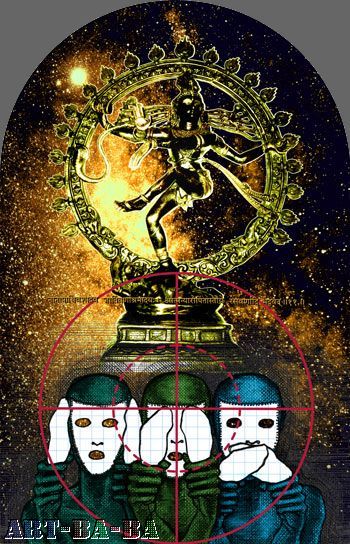
The Color Wheel Series, First Adhyasa: Annomayakosha #27
Meta-Art Statement: The Color Wheel Series (2004)
First Adhyasa: Annomayakosha #26
web site image | 网络图片
2000

The Color Wheel Series, First Adhyasa: Annomayakosha #27
Meta-Art Statement: The Color Wheel Series (2004)
Everything #2/11b | 一切 2#/11b
2003
复印、文字,8.5 x 11"
graph paper, photocopied photo overprint, erasure, inkjet text overprint, 8.5 x 11”

2003
复印、文字,8.5 x 11"
graph paper, photocopied photo overprint, erasure, inkjet text overprint, 8.5 x 11”

Everything #10 | 一切10#
2007
durational performance for an unspecified number of participants
行为
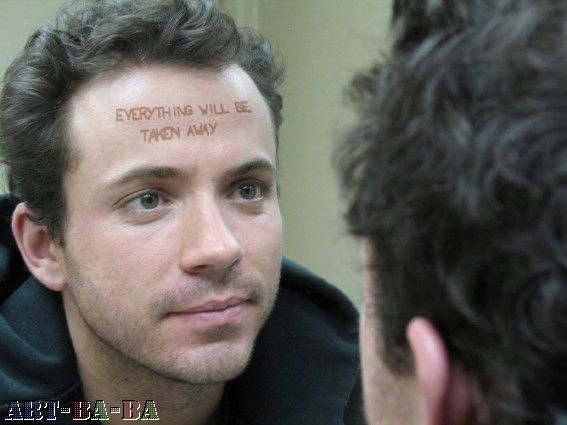
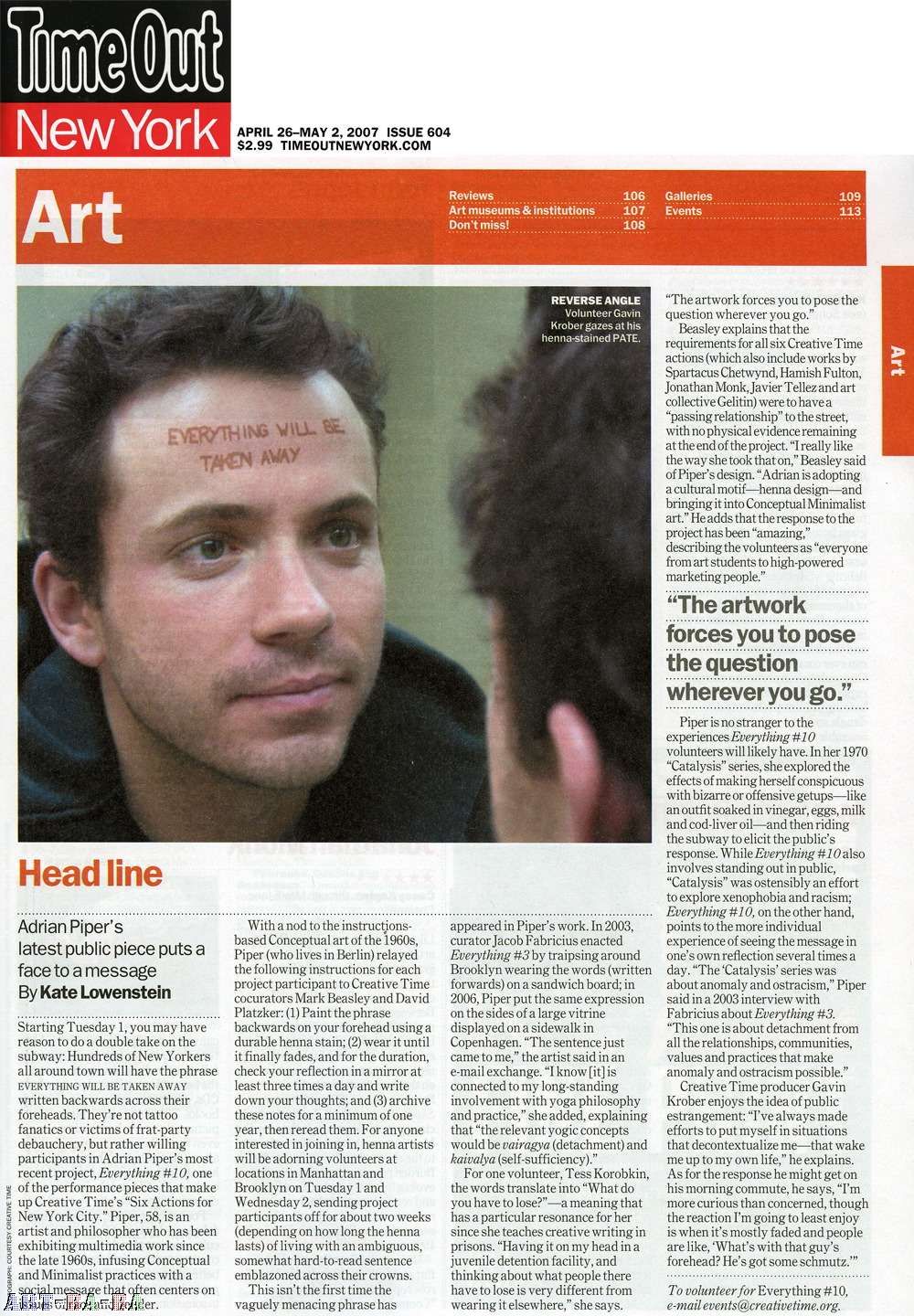
Adrian Piper 做了一个诗意和哲学行为。文字“一切会被拿走”用染料被写在不同的参加者上。字是反过来写上去:只能通过一个镜子才能读出来。染料过1到2个星期会消失掉。参加者要写一个日记,记录它们的经验。
Adrian Piper creates a poetic and philosophical duration performance in which the text “Everything will be taken away” will be written, in henna, on an unspecified number of participants’ foreheads that respond to an open call. The henna will be applied to respondents on May 1 and May 2. Written in reverse, the message becomes readable when seen through the reflection of a mirror, and the dye is anticipated to endure on the skin for 1- 2 weeks. The participants will be asked keep journals of their experiences and audience reactions during the project, then re-read the journals a year after the performance. Written directly on the forehead the text suggests the layered, shifting organization and loss of memory. It is both a promise and a threat. What will be taken away and what do we consider to be ‘our’ everything?
Everything will be taken away is labeled #10 as it is the tenth rendition of the ongoing series the artist began in 2003. The simple prose has been displayed in a variety of media including sandwich boards and on personal photographs that have been photocopied, printed and erased. Contingent upon the context and relationship to the audience, the sentence reveals new aspects of its potential meanings with each adaptation. The endurance and repetition of the phrase is crucial to the series and the relationship to Piper’s writings and philosophical work. A student and teacher of philosophy and meta-ethics, Piper often employs Hindu philosophical imagery and concepts, such as the henna used in this project.
2007
durational performance for an unspecified number of participants
行为


Adrian Piper 做了一个诗意和哲学行为。文字“一切会被拿走”用染料被写在不同的参加者上。字是反过来写上去:只能通过一个镜子才能读出来。染料过1到2个星期会消失掉。参加者要写一个日记,记录它们的经验。
Adrian Piper creates a poetic and philosophical duration performance in which the text “Everything will be taken away” will be written, in henna, on an unspecified number of participants’ foreheads that respond to an open call. The henna will be applied to respondents on May 1 and May 2. Written in reverse, the message becomes readable when seen through the reflection of a mirror, and the dye is anticipated to endure on the skin for 1- 2 weeks. The participants will be asked keep journals of their experiences and audience reactions during the project, then re-read the journals a year after the performance. Written directly on the forehead the text suggests the layered, shifting organization and loss of memory. It is both a promise and a threat. What will be taken away and what do we consider to be ‘our’ everything?
Everything will be taken away is labeled #10 as it is the tenth rendition of the ongoing series the artist began in 2003. The simple prose has been displayed in a variety of media including sandwich boards and on personal photographs that have been photocopied, printed and erased. Contingent upon the context and relationship to the audience, the sentence reveals new aspects of its potential meanings with each adaptation. The endurance and repetition of the phrase is crucial to the series and the relationship to Piper’s writings and philosophical work. A student and teacher of philosophy and meta-ethics, Piper often employs Hindu philosophical imagery and concepts, such as the henna used in this project.
THE RESEARCH ARCHIVE |研究文献
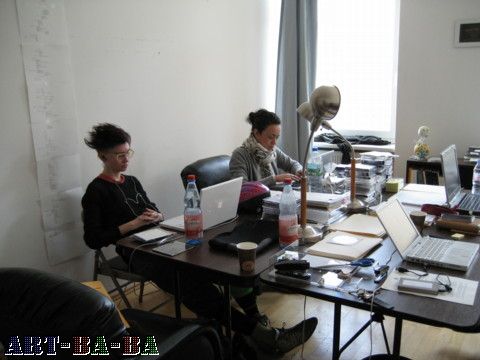
Adrian Piper 2002年由于被诊断患上一个无可医疗、致命的病就创立了Adrian Piper研究文献(APRA)。两年之后即使她2005年到德国了之后恢复了,她还是决定发展APRA作为一个公共资源。APRA 包括:
1. Piper的文献(信、文字、资料、家庭照片、书、画册、书店⋯⋯)
2. 一个网站为:www.adrianpiper.com 提供Piper生活和工作相关信息。
Adrian Piper founded the Adrian Piper Research Archive (APRA) in 2002, after being diagnosed with a progressive, incurable and fatal medical condition. Although the condition had vanished within two years after her move to Germany in 2005, Piper decided to continue developing APRA as a personal and public resource. APRA comprises
1. the archive housing Piper's art work, correspondence, manuscripts, documents, family photo and letters archive; book, catalogue and articles library; video and sound work library; reproductions library; Vedic and Western philosophy library, art library, fiction and poetry library, music collection, video collection; artwork inventory, text inventory; and, eventually, preserved personal living and working space, furnishings, and personal possessions exactly as she designed, built, arranged and/or used them;
2. the web site located at www.adrianpiper.com, offering professional and biographical information about Piper's life and work.



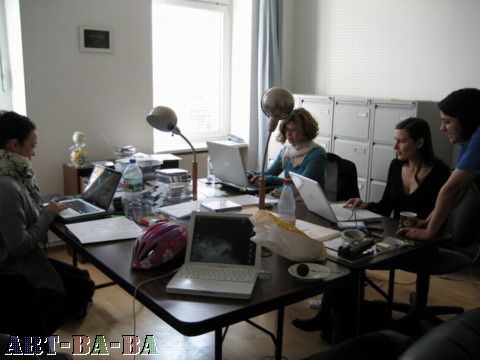

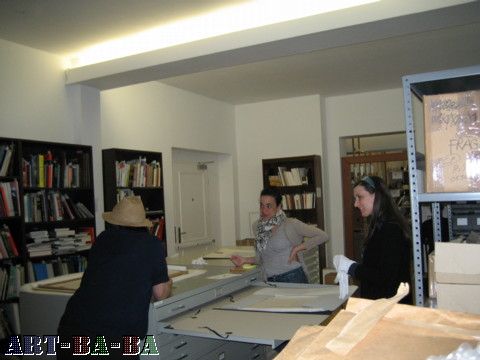

Adrian Piper 2002年由于被诊断患上一个无可医疗、致命的病就创立了Adrian Piper研究文献(APRA)。两年之后即使她2005年到德国了之后恢复了,她还是决定发展APRA作为一个公共资源。APRA 包括:
1. Piper的文献(信、文字、资料、家庭照片、书、画册、书店⋯⋯)
2. 一个网站为:www.adrianpiper.com 提供Piper生活和工作相关信息。
Adrian Piper founded the Adrian Piper Research Archive (APRA) in 2002, after being diagnosed with a progressive, incurable and fatal medical condition. Although the condition had vanished within two years after her move to Germany in 2005, Piper decided to continue developing APRA as a personal and public resource. APRA comprises
1. the archive housing Piper's art work, correspondence, manuscripts, documents, family photo and letters archive; book, catalogue and articles library; video and sound work library; reproductions library; Vedic and Western philosophy library, art library, fiction and poetry library, music collection, video collection; artwork inventory, text inventory; and, eventually, preserved personal living and working space, furnishings, and personal possessions exactly as she designed, built, arranged and/or used them;
2. the web site located at www.adrianpiper.com, offering professional and biographical information about Piper's life and work.






展览现场
”一切都会被拿走“
2010年10月23日至2011年1月9日
Cairn Gallery, Pittenweem, 苏格兰

”一切都会被拿走“
2010年10月23日至2011年1月9日
Cairn Gallery, Pittenweem, 苏格兰
